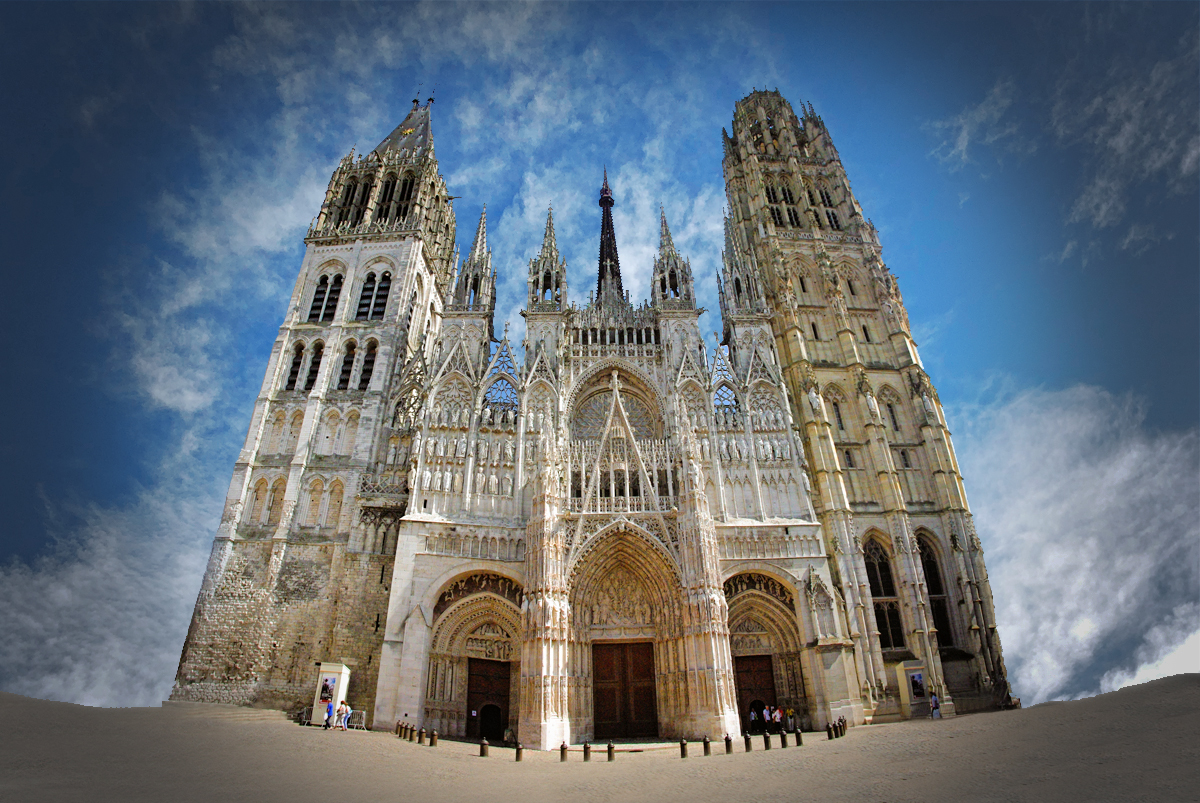Rouen Cathedral is arguably the most prestigious monument in this fascinating city of Normandy.
It is one of the most exquisite pieces of pure Flamboyant work existing.
It is also the tallest cathedral in France, with its spire reaching 151 metres high.
Standing at Place de la Cathédrale, Rouen Cathedral appears in all its glory. Its stunning west front comprises two mighty towers: Tour de Beurre and Tour Saint Romain.
Breaking News! The 2024 Fire of the Spire
On Thursday, 11th July 2024, around noon, a fire broke out at the Rouen Cathedral, causing significant concern among locals and officials.
The blaze, which ignited at the spire’s summit, quickly attracted the entire city’s attention.
Another French Gothic wonder has just gone up in flames.
This time it’s the 800-year-old Rouen Cathedral…pic.twitter.com/UiQE9Tj7mC
— Culture Critic (@Culture_Crit) July 11, 2024
According to Actu.fr, by 12:15 PM, smoke was visible across Rouen, with numerous sirens echoing throughout the city.
Crowds gathered around the cathedral, capturing the event on their devices.
Fortunately, the fire was contained by 2 PM, thanks to the efforts of 70 firefighters.
Rouen’s mayor, Nicolas Mayer-Rossignol, confirmed on X (formerly Twitter) that all public resources were mobilised, although the fire’s origin remains unknown.
Archbishop Dominique Lebrun, present at the scene, assured franceinfo that there were no casualties, apart from workers who had inhaled smoke and were being treated by the fire brigade.
The Normandy and Seine-Maritime Prefecture confirmed the cathedral’s evacuation and advised the public to avoid the area and keep emergency lines clear.
Although objects on the platform and a protective white tarp caught fire, the spire itself, the tallest in France at 151 metres, remained unthreatened.
Specialised rescue teams were deployed, and police restricted access to the Cathedral Square to ensure safety.
By 12:30 PM, the smoke had thinned, revealing a large hole in the tarp.
The cathedral, which has been undergoing renovations since 2016, sustained significant damage, particularly around the metal spire’s midpoint.
Archbishop Lebrun highlighted the urgency of delivering water to the upper sections to extinguish the fire and inspect other parts of the cathedral.
He noted that the fire appeared to have started in an area where workers decontaminated themselves after their shifts.
As videos of the incident spread on social media, the archbishop expressed profound sorrow for the archdiocese staff and the local population, acknowledging the extensive damage and the need for thorough assessments of the fire’s impact.
Description and Facts about Rouen Cathedral
Of the cathedral, author Ruskin wrote:
“It is the most exquisite piece of pure Flamboyant work existing. There is not one cusp, one finial, that is useless, not a stroke of the chisel is in vain; the grace and luxuriance of it all are visible— sensible, rather, even to the uninquiring eye; and all its minuteness does not diminish the majesty, while it increases the mystery of the noble and unbroken vault.”
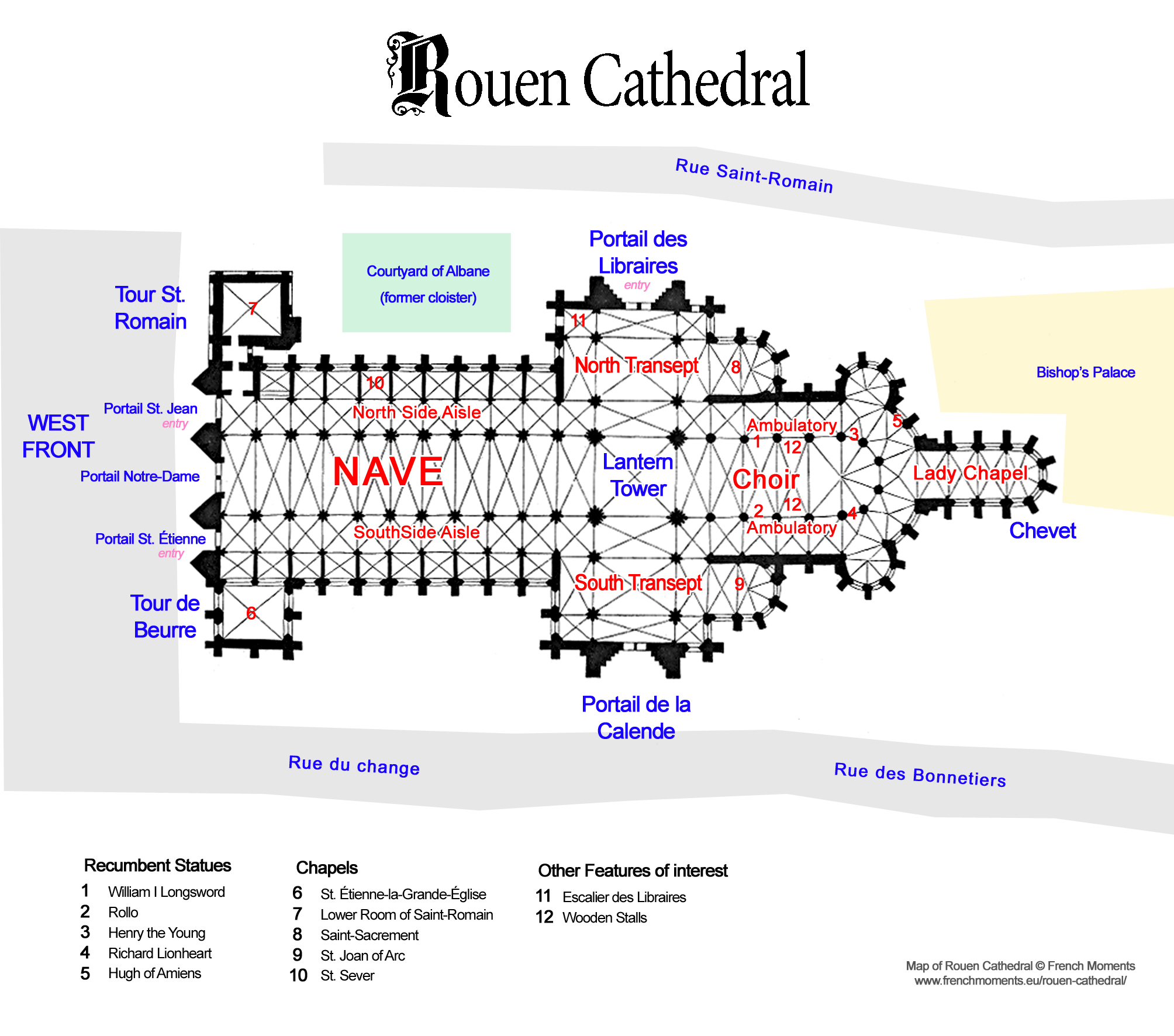
The seat of the Roman Catholic Archdiocese of Rouen
The Archbishop of Rouen has his seat in the Rouen Cathedral and is one of the 15 archbishops in France. Legend has it that Nicasius founded the shrine circa 250. This disciple of St. Denis suffered martyrdom in Normandy.
As the archbishop also bears the title of Primate, the cathedral is also a primatial church.
Rouen is also the only city in France to have an adjoining archepiscopal palace still occupied by an archbishop today.

Height record
Until 1876, the world’s tallest building was the cathedral of Strasbourg, with its bell tower reaching 142 m.
With the addition of the new cast iron spire on the lantern tower, Rouen became the tallest building in the world (151 m), a record yielded by Cologne Cathedral just four years later in 1880 (157 m).
Rouen keeps the record of being the tallest cathedral in France.
Rouen Cathedral: A bit of History
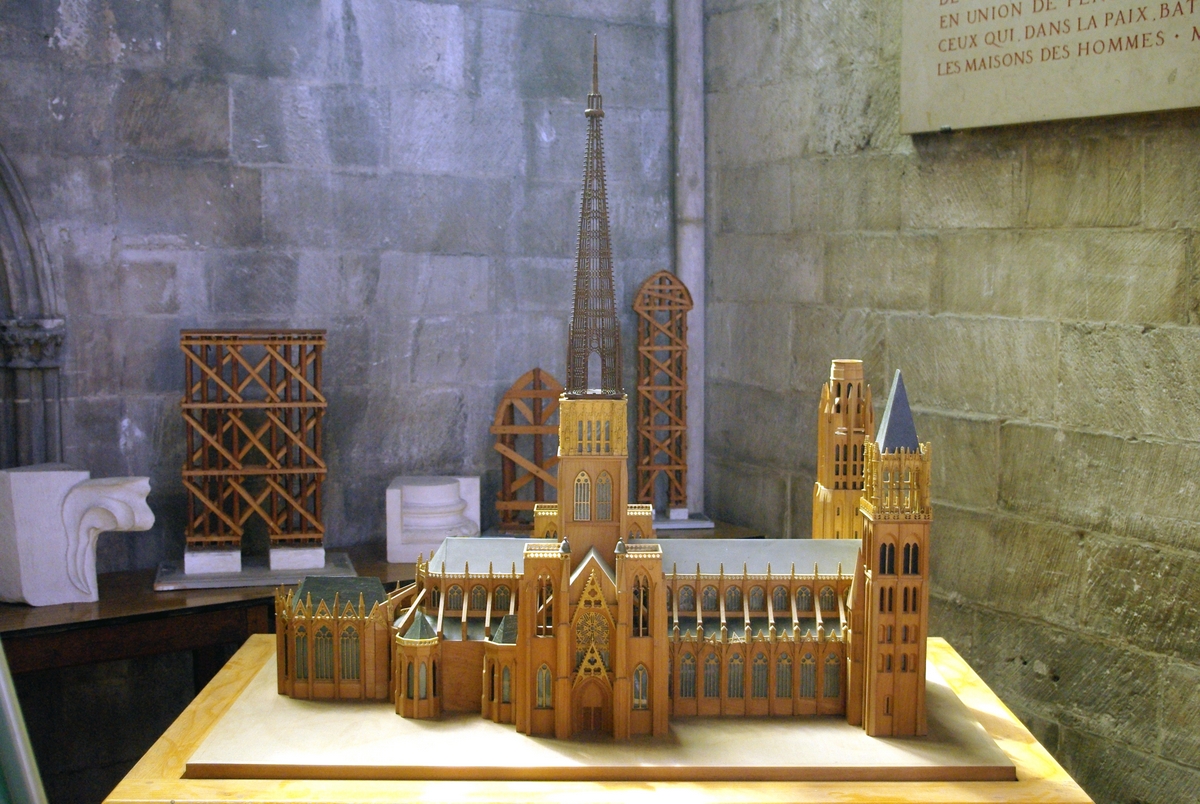
The existing cathedral was not the first standing on the site. In the 11th century, Rouen built a Romanesque edifice. Archbishop Maurille dedicated the sanctuary in 1063.
Following the end of the 19th-century excavations, archaeologists discovered the Romanesque crypt. This is the only archaeological remains of the former cathedral. According to scholars, it would have been of similar size as the famous abbatial church of Jumièges, whose most celebrated ruins lie some miles away from the city of Rouen.
When the Gothic style was trending!
When Gothic architecture became fashionable in Western Europe, the religious authorities decided to replace the Romanesque building with a more prestigious one. This would show the world the greatness and prestige of Rouen, then one of the largest cities of Western Europe.
Less than a century after the dedication of the Romanesque cathedral, Archbishop Hughes of Amiens planned the construction of the new building, starting from the facade and gradually covering the Romanesque nave with a Gothic one… until a fire devastated the whole district during Easter 1200, destroying everything that remained of the Romanesque cathedral.
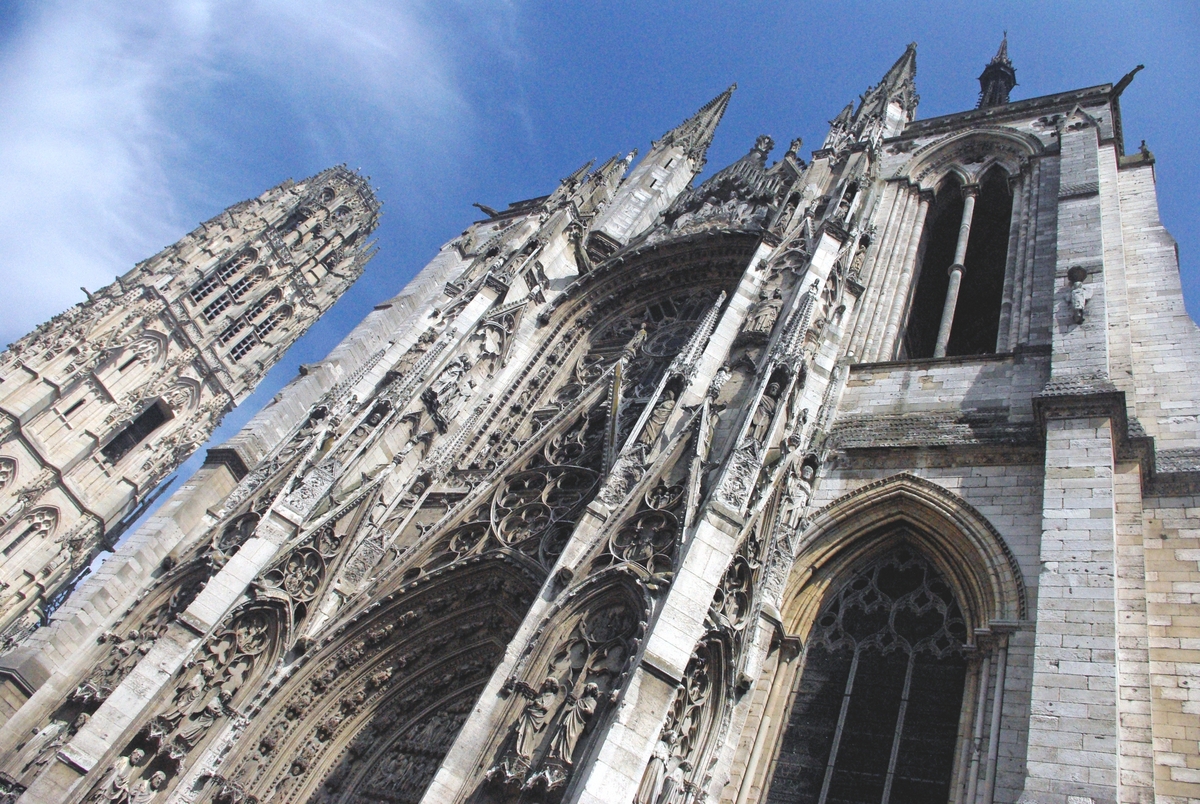
Cathedral builders completed the Gothic nave between 1234 and 1237 and the side chapels around 1265-1275. The monumental western façade took a relatively long time to build (1370-1450).
1478 saw the completion of the Saint-Romain tower. However, its counterpart – the Tour de Beurre – took longer (ended in 1506). As for the Lantern Tower at the crossing of the transept, architects topped it in 1557 with a gilded lead spire reaching 128 m.
During the Wars of Religion, the Huguenots sacked the cathedral in 1562, hence the absence or deterioration of statues.
Rouen Cathedral at the French Revolution
During the French Revolution, the new authorities in place transformed the cathedral into a Temple of Reason.
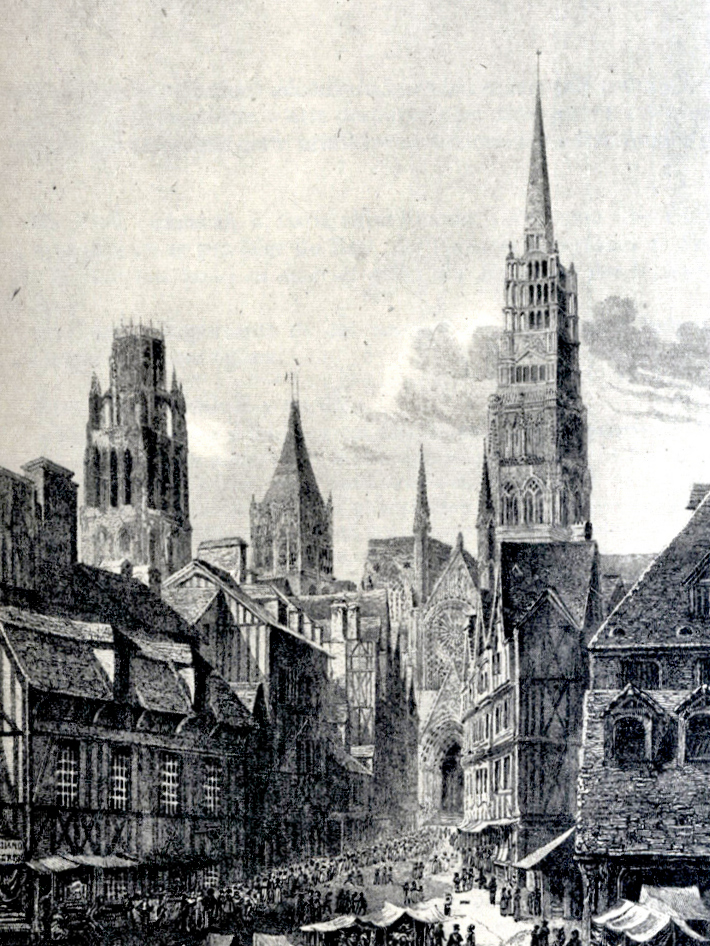
In 1822 thunder hit the lantern tower of the cathedral, destroying the Renaissance spire. The present-day spire replaced it in 1876.
The damages of WW2
In 1944, Allied bombing during the week before D-Day did a lot of damage to the cathedral, which was hit by seven bombs. Fortunately, one of them landed in the choir and never exploded.
The other six bombs destroyed the South aisle of the nave and the chapels. One of the four pillars supporting the lantern tower and its spire was seriously damaged.
Urgent repairs were made to prevent the spire from crashing into the building.
As for the nave, it remained firmly in place, thanks to the counterweight of the flying buttresses of the Sainte-Catherine Chapel.
On June 1, 1944, the Saint-Romain tower caught fire, and its bells fell. It took several years to repair the cathedral, which reopened in 1956.

Rouen Cathedral nowadays…
The violent storm of December 1999 damaged the lantern tower and the choir when the 26-ton Northeast turret fell into the cathedral.
On May 30, 2015, the restoration work on the West front ended with the removal of scaffolding. For the first time, the people of Rouen and visitors alike could admire the cathedral in all its glory.
Since 2017, restauration works have focused on the cathedral’s spire. The renovated spire will change colour by the end of January 2020. Its former dark colour will give way to a grey-green-blue tint, much more aligned with its history.
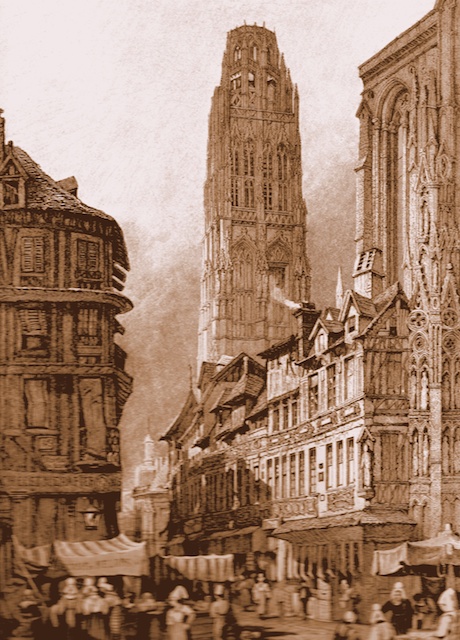
My book recommendation!
Its name? Simply:
Gothic: Architecture, Sculpture, Painting by Rolf Toman, Publisher: Ullmann
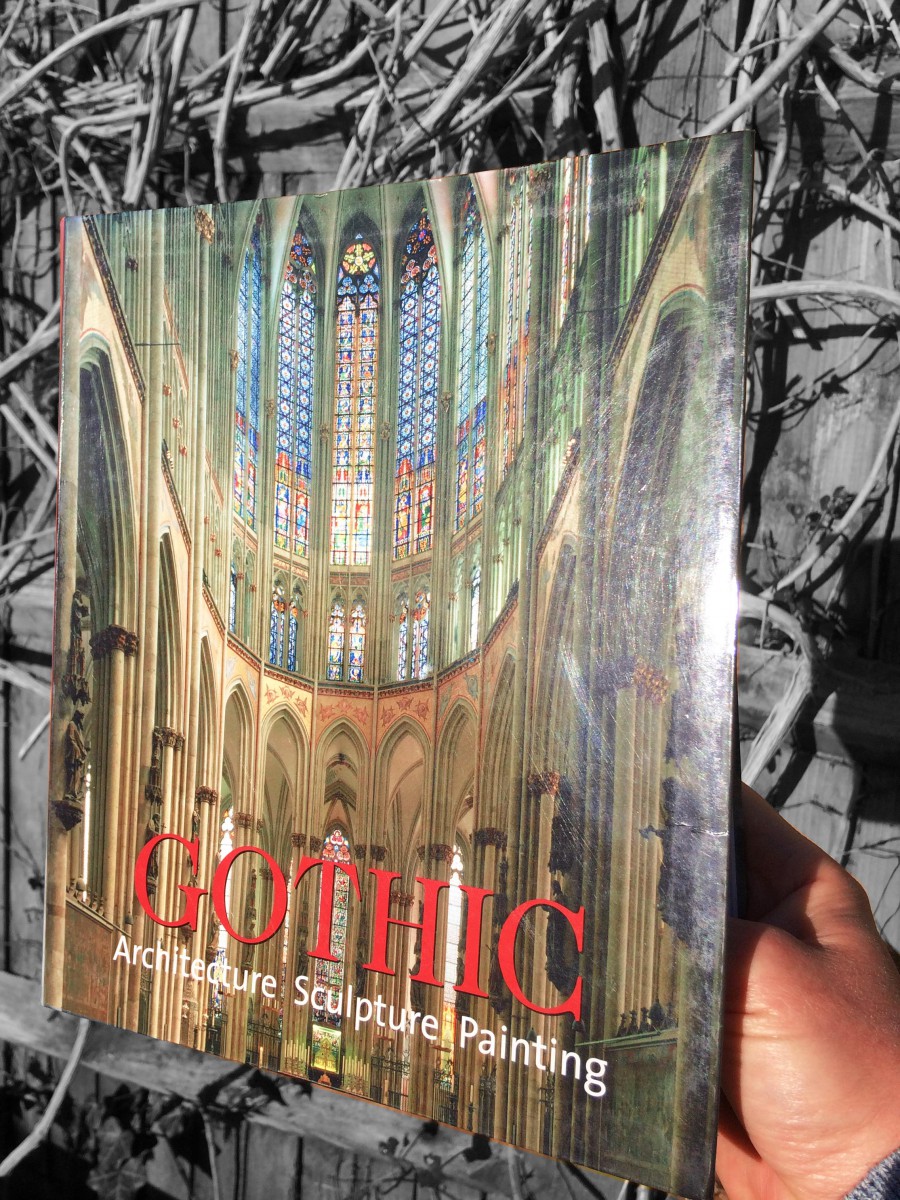
This book has been a great resource that helped me better understand the Gothic movement in art from the 12th century to the Renaissance. An architectural style that first originated in France and spread all over Europe.
Over 500 pages, it focuses on the development of Gothic architecture with many illustrations and photographs, but not only. I’ve also found the in-depth discussion of the most diverse art forms, including painting, sculpture, metalwork and even book illumination, attractive! It also includes specific coverage of the Cathars’ Heresy and the Papal Palace in Avignon. And, of course, it mentions the Notre Dame de Rouen cathedral!
This is the book I recommend if – like me – you love everything about Gothic, such as churches, gargoyles, stained glass, flying buttresses, and so much more.
The exterior of Rouen Cathedral
The beauty of Rouen Cathedral is best appreciated from the Place de la Cathédrale, without forgetting the portals of the transepts (Calende and Librarians) and the soaring Lantern Tower.
The West Façade
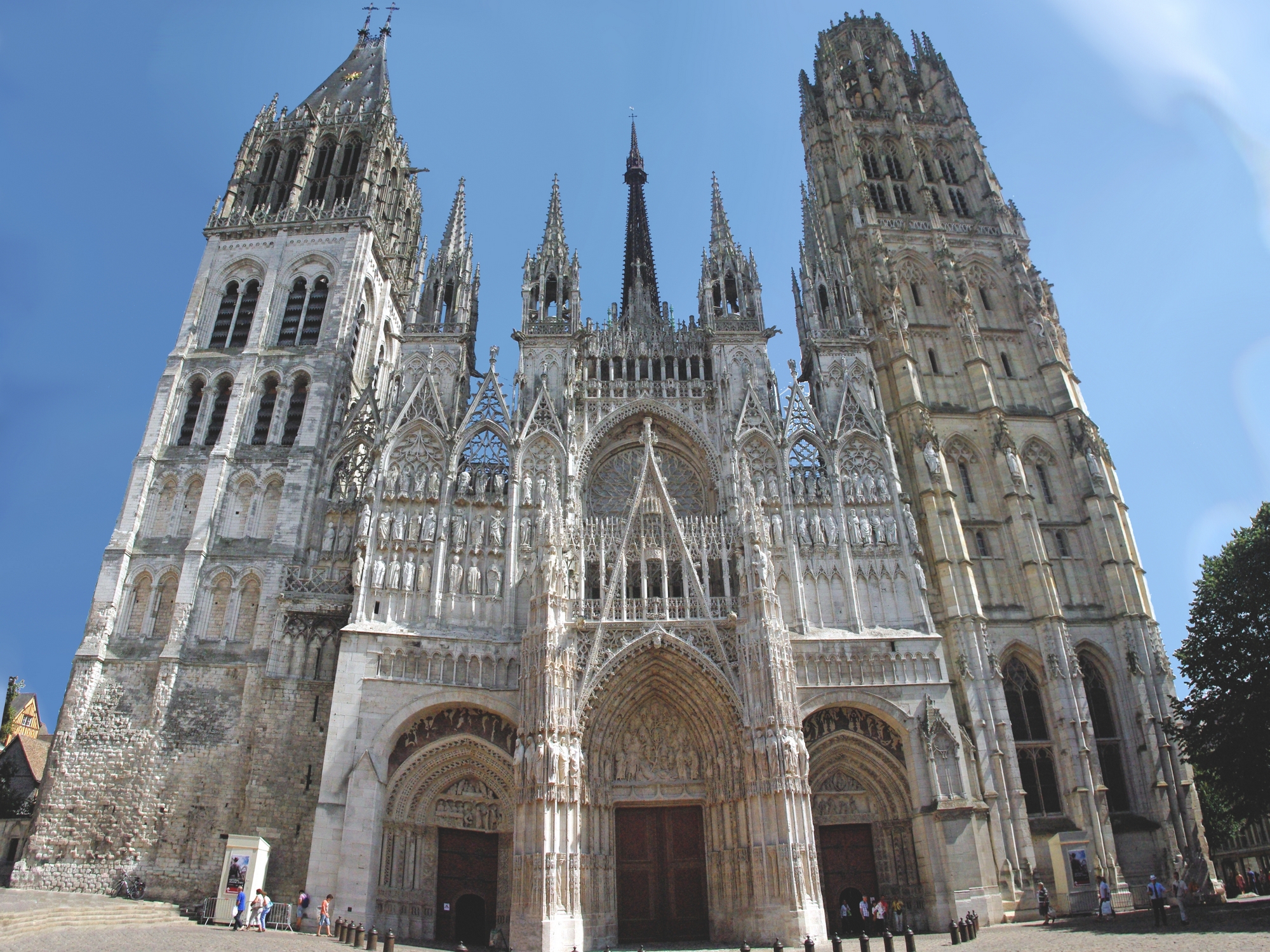
With the Tour Saint Romain to the left and the Tour de Beurre to the right, the facade is a fantastic set of towers, pinnacles, statues and porches.
It is, therefore, no surprise that it was often painted by the impressionist Claude Monet. The painter composed a series of 28 paintings of the Western facade at different times of the day. His work is exhibited in various museums spread between:
- America (National Gallery of Art, Washington, D.C., Getty Center, Los Angeles), and
- Europe (National Museum of Serbia, Belgrade, museum of Cologne, Germany, Fine Art Museum, Rouen and musée d’Orsay, Paris).
These details make it a grand sanctuary
The two tall towers contrast with other renowned cathedrals in France as they do not rise above the aisles but at the sides.
The two aisle porches follow the early Gothic style, but their tympana is an addition from the 13th century. The main porch was the last Gothic element added to the cathedral, built to reinforce the facade, which had been subsiding after the erection of the Tour du Beurre.
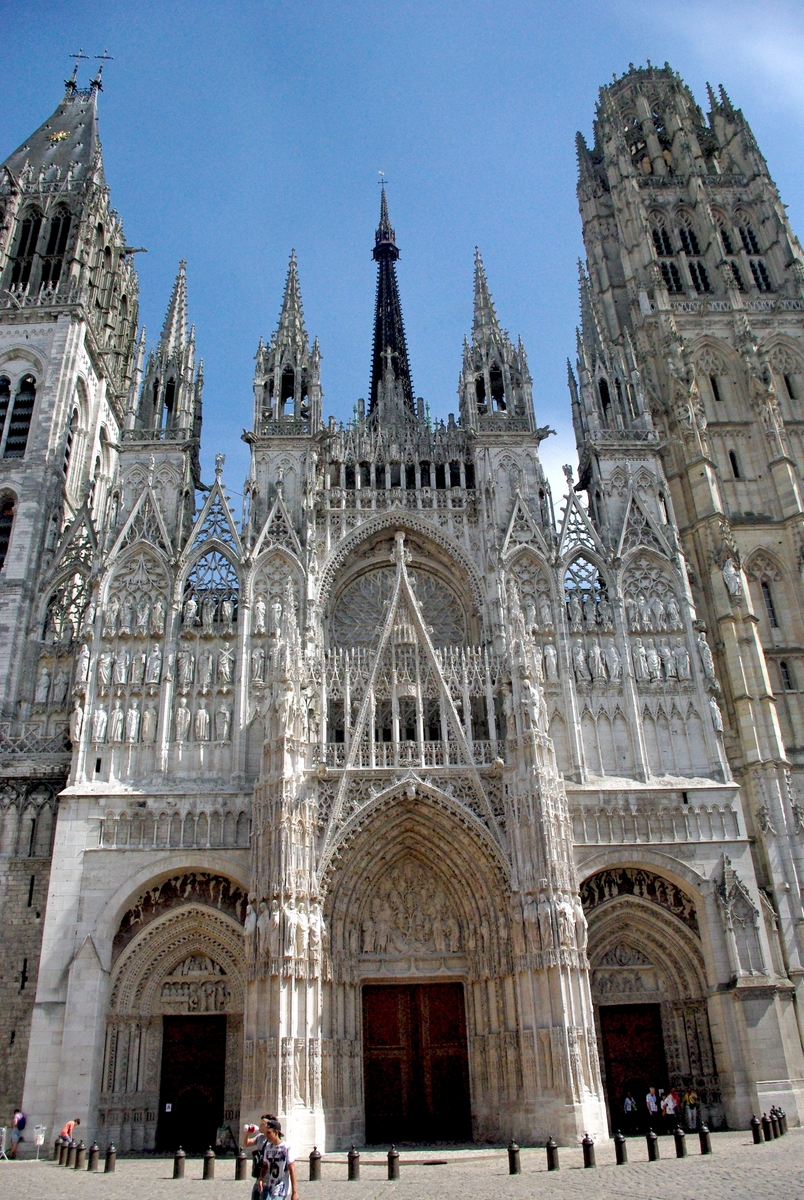
The rose window above is the fourth replacement and dates back to just after the Second World War.

Niches house rows of statues on both sides. There are two galleries of statues in the South and three in the North, a unique feature in France, although common in England. This is evidence of British influence in the Gothic style of the cathedral.
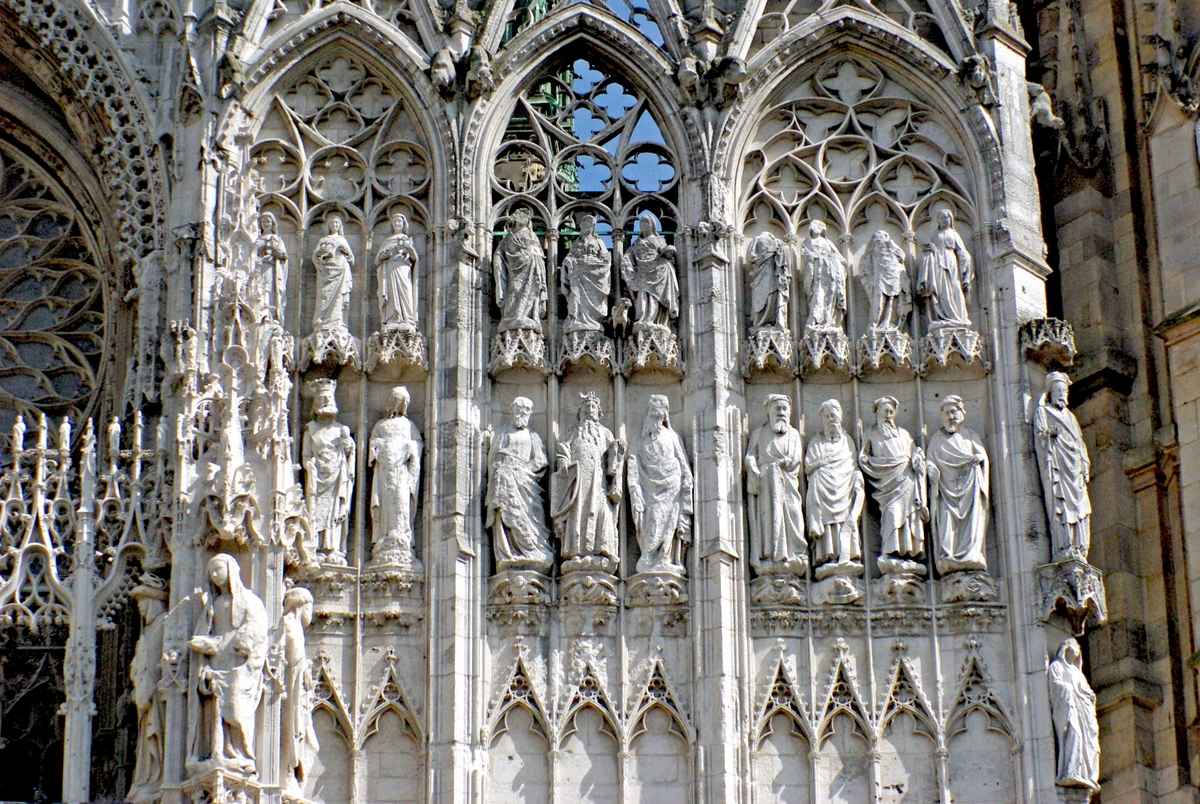
The higher part
Fine Rayonnant and flamboyant-style gables decorate the façade’s upper part. At the top of the facade, pyramid-shaped pinnacles crown the whole ensemble.

Find out more about the West Façade of Rouen Cathedral.
La Tour de Beurre
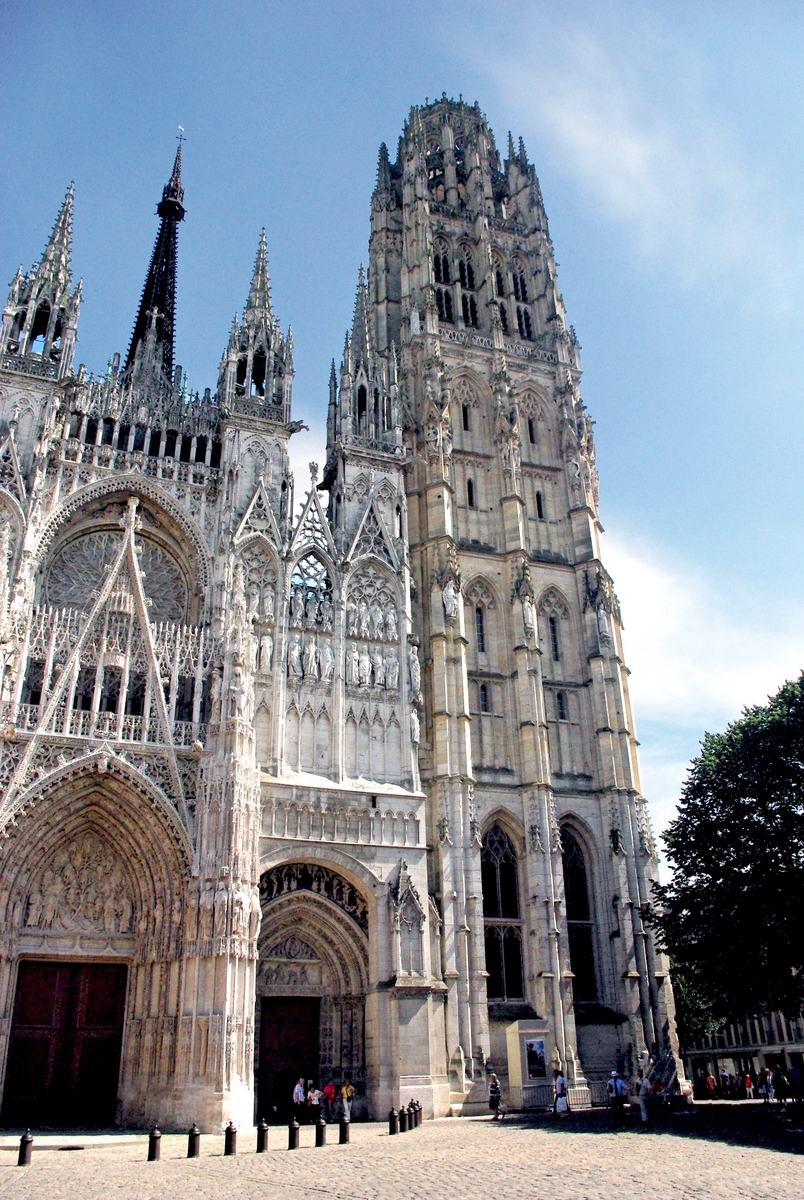
The Tour de Beurre dates back to the end of the 15th century. Its name derives from the word for butter, banned during Lent.
The last storey is a Gothic marvel, transforming the squared plan into an octagonal one. Scholars believe that the architect of the time wished to complete the tower with a stone spire. However, the canon priests were too scared of the cost of such a work and demanded that a refined balustrade be built instead.
Find out more about the Tour de Beurre.
La Tour Saint Romain

On the northern side of the facade lies the mighty Tour Saint Romain, four centuries older than its counterpart. Work on the tower started in 1145, so it is the oldest part of the Gothic construction. Its last Flamboyant style storey clashes with the rest of the more sober building. The Saint Romain tower burnt down on the 1st of June 1944, after the Allied bombing the day before. Its unusual axe-like roof, covered with slates and decorated with a gilded sun image, has been reconstructed only recently.
Find out more about the Tour Saint-Romain.
The Lantern Tower, the glory of Rouen Cathedral
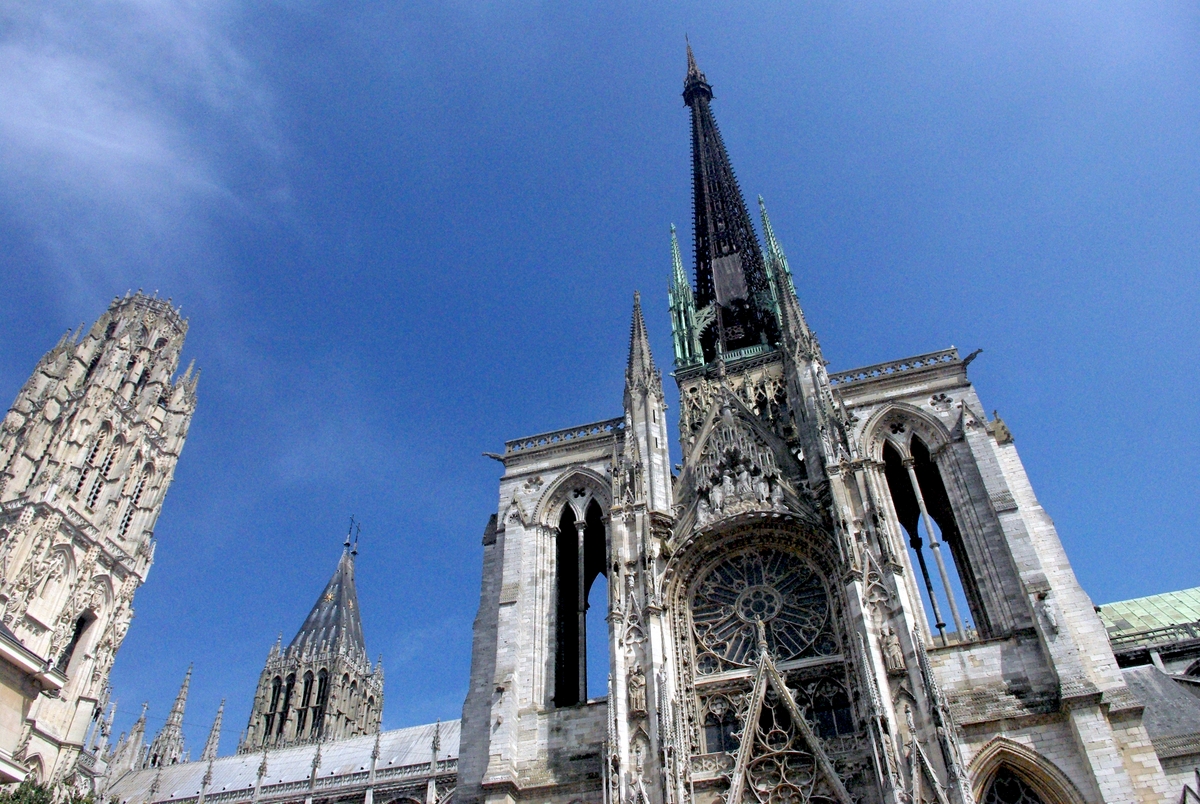
The last major addition to the cathedral’s structure was the 19th-century cast iron spire on the lantern tower. Reaching a height of 151 metres, it replaces a former lead-covered timber Renaissance spire from the 16th century, which burned down in 1822.
Interestingly the vast tower follows the traditional characteristic of Gothic style in Normandy, having a lantern tower at the crossing of the transept.
Fifty years needed to build the structure!
It took some 50 years to construct the existing cast iron spire. Between 1880 and 1884, architect F. Marrou added four beautiful copper-clad wooden turrets around the spire at the base of the lantern tower.
However, the North-east turret, weighing 26 tons, was missing following the violent storm of December 1999, which also damaged the choir and the stalls in its fall. The three other turrets were removed for maintenance and safety purposes before being replaced in 2012.
Find out more about the Lantern Tower of Rouen Cathedral.
The Librarians Portal
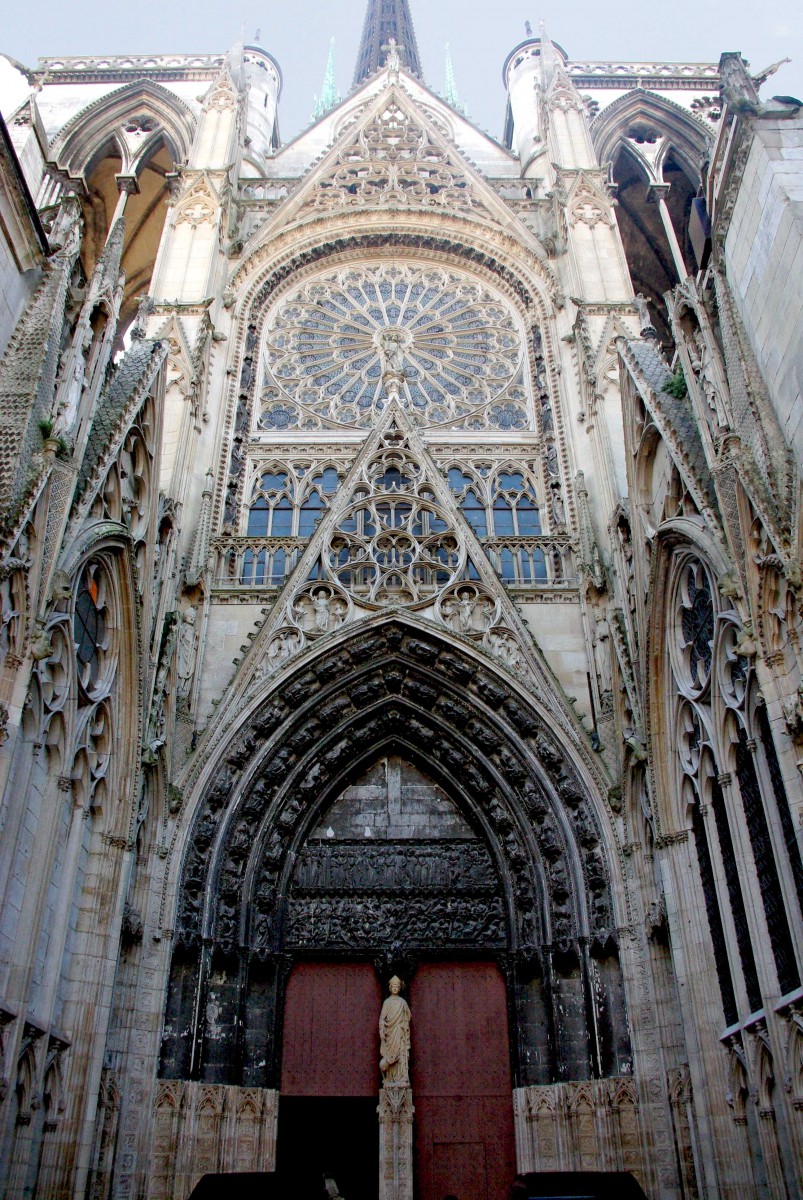
The Librarians Portal (Portail des Libraires) is situated at the North end of the transept of Rouen Cathedral. Once the canon priests had private access to the cathedral, the portal was a beautiful example of Gothic architecture in Normandy. Its name refers to the transcribers and calligraphists whose shops once occupied the courtyard.
Find out more about the Librairians Portal.
The Calende Portal

The Calende Portal (Portail de la Calende) is situated in the South end of the transept of Rouen Cathedral. Richly decorated, the portal dates to the 15th century.
Find out more about the Calende Portal.
Rouen Cathedral’s buttresses
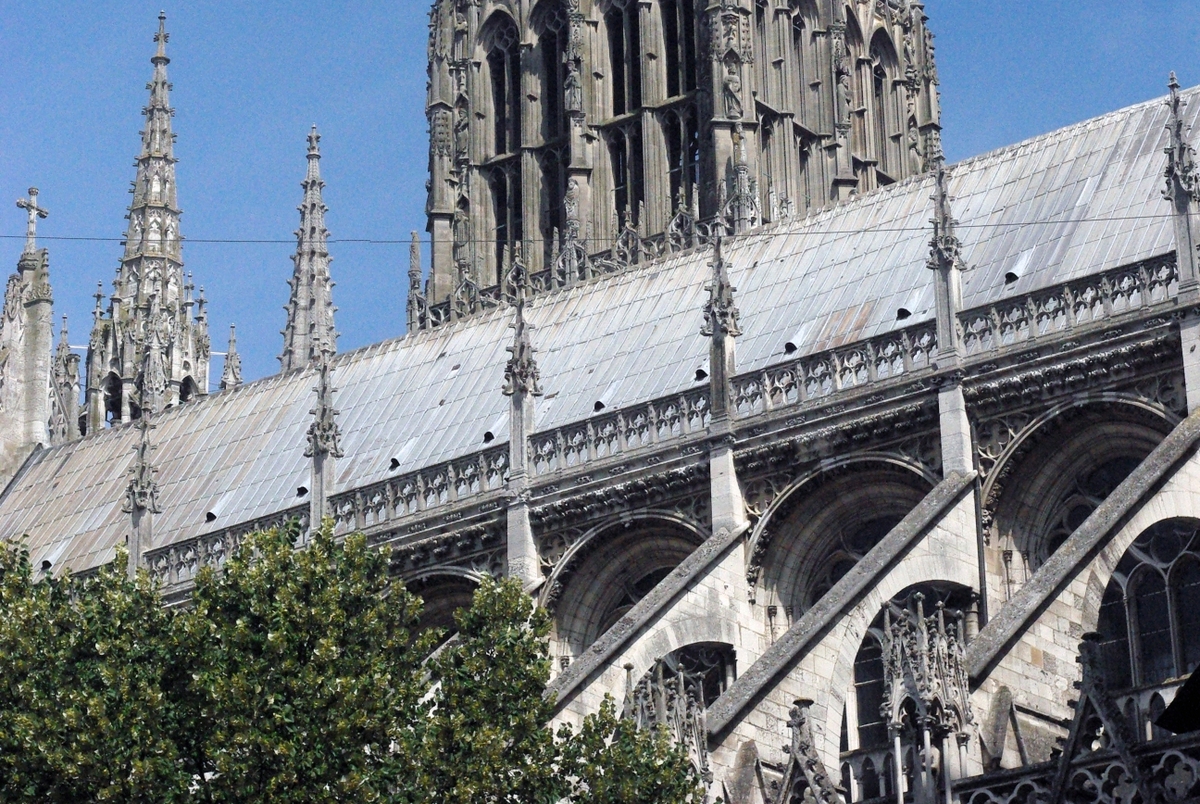
Elegant flying buttresses ornate with pinnacles surround the nave on both sides.
The Cathedral’s Chevet
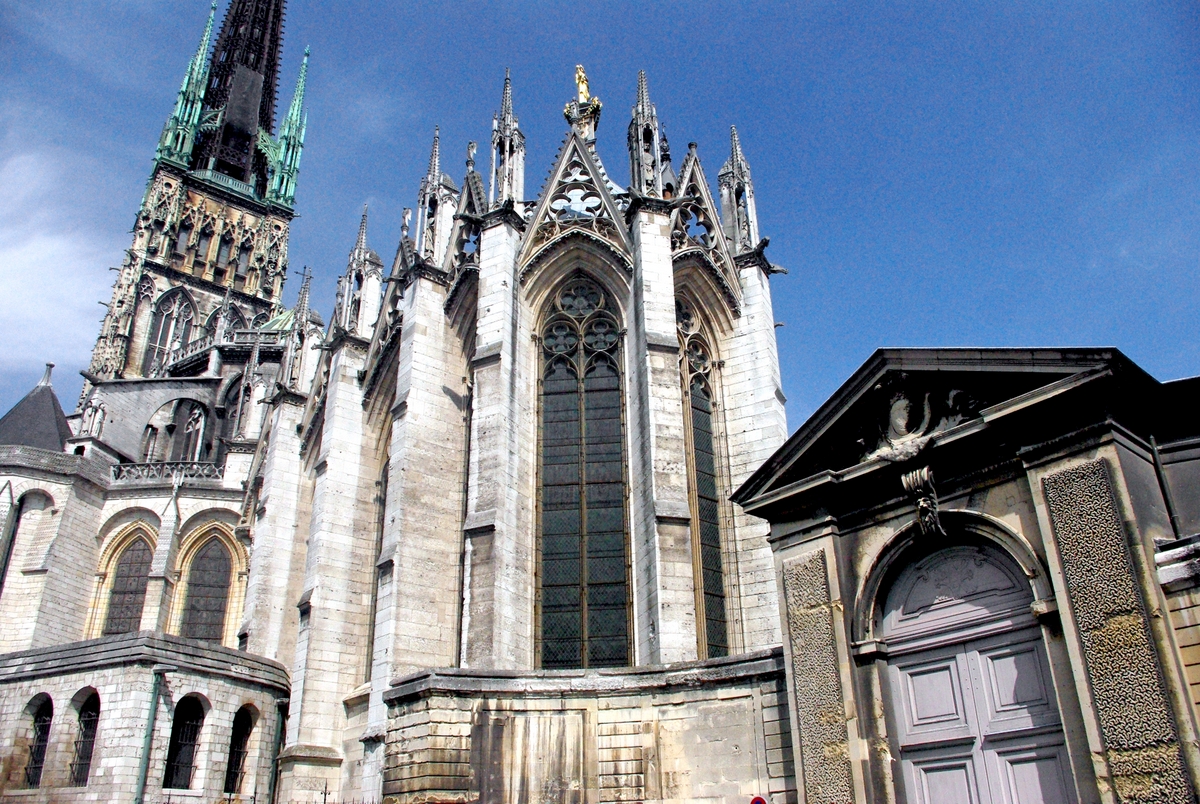
The cathedral’s chevet ends with the Lady Chapel (1430-1538). Between the buttresses and their pinnacles are pointed windows topped with gables. On the chapel roof stands a statue of the Virgin from 1541.
The cloister-court
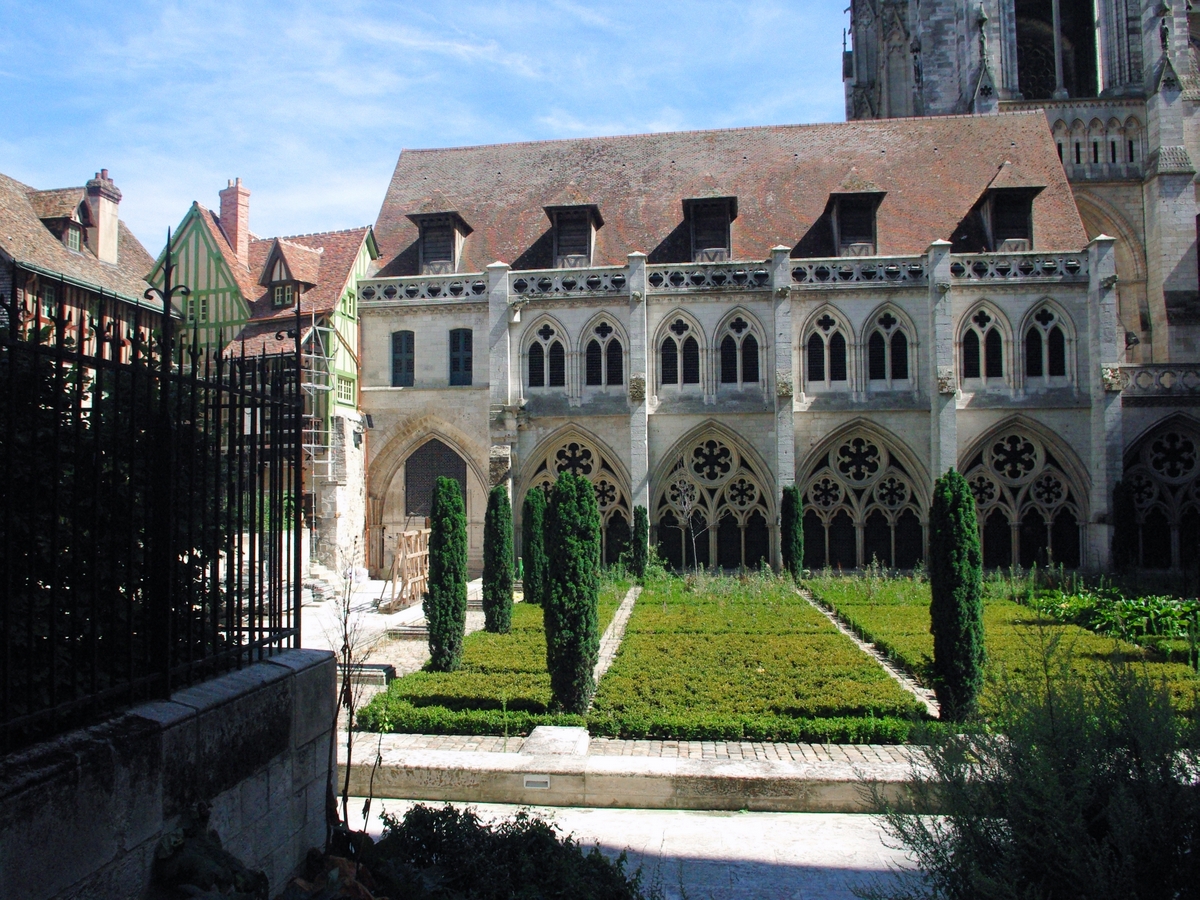
The garden of the cloister court lies on the northern side of the cathedral. Only a few arches of the cloister were built on the eastern side. Moreover, the green space that occupies the courtyard is now known as Cour d’Albane and was recently renovated.
Inside the cathedral
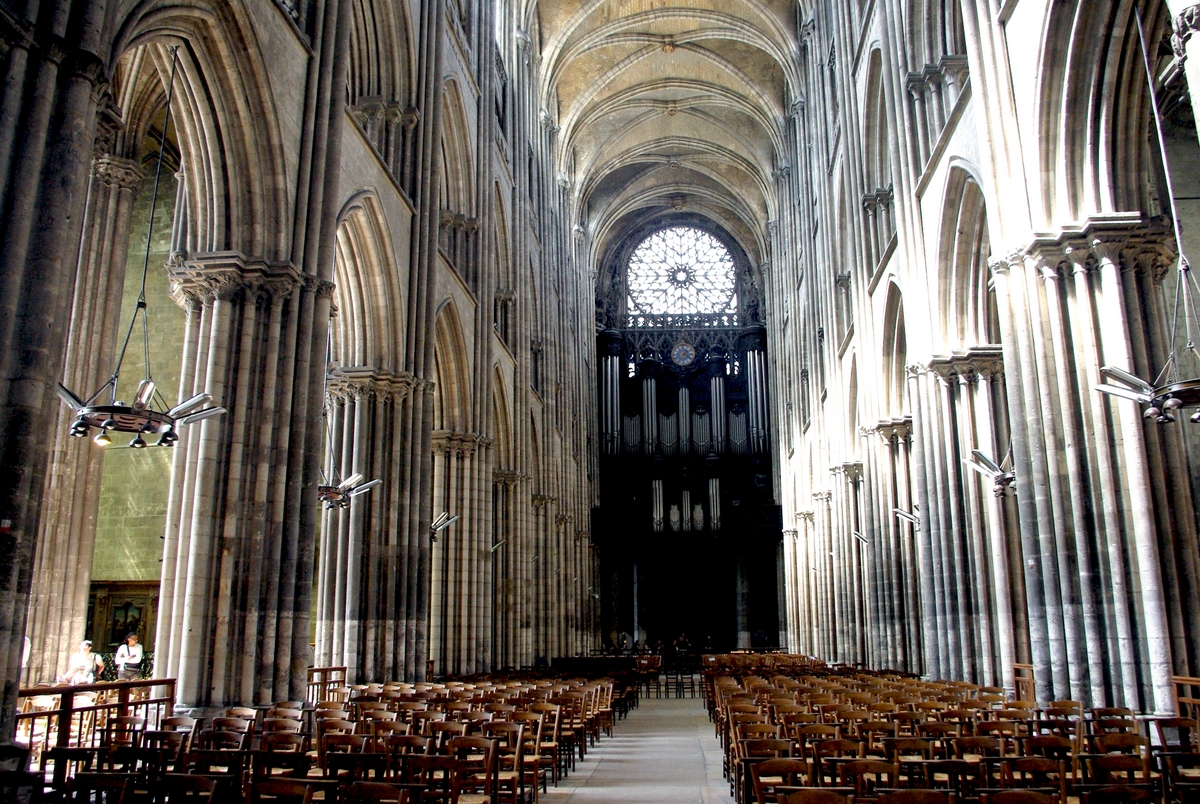
On entering the cathedral, the eye has an uninterrupted view of its whole length through a vista of lofty pillars and pointed arches.
Scholar Bond considers the interior of the Cathedral of Rouen to be curiously Romanesque in plan:
“Its nave bays are four-storied, an upper and lower pier arch with small triforium and clerestory. The upper pier arch might also be regarded as a triforium, for a passage-way runs along the sill of the arch and is continued behind the main piers on an elegant group of shafted corbels. These were originally intended to support a vault of a lower aisle. The east end is more dignified and has simpler factors, clerestory, triforium and pier arch. The glass is magnificent, dating from the thirteenth century.”
The Cathedral’s Nave
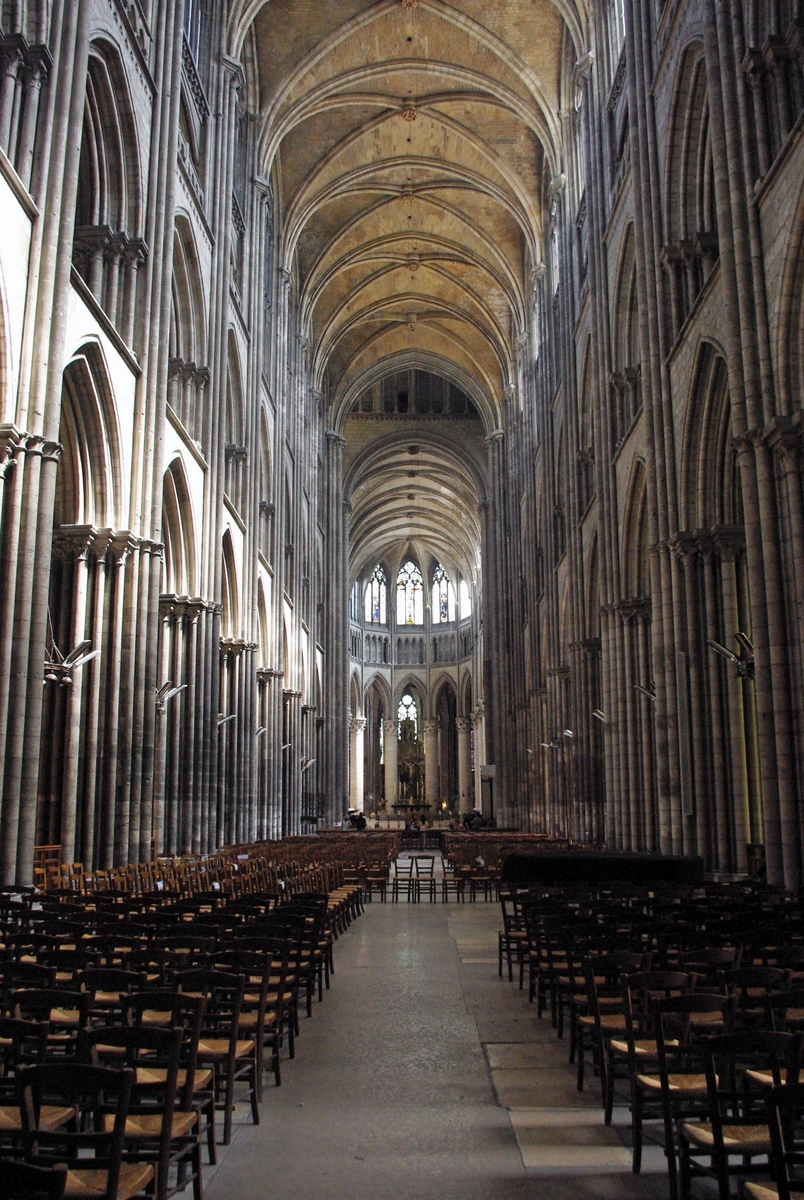
The nave dates back to the 12th century, and the aisles and vaults to the 13th century. It includes 11 spans, totalling 60 metres.
The height of the vaults reaches 28 metres, much lower than the cathedral of Metz (41 metres) and France’s record at Beauvais Cathedral (48m).
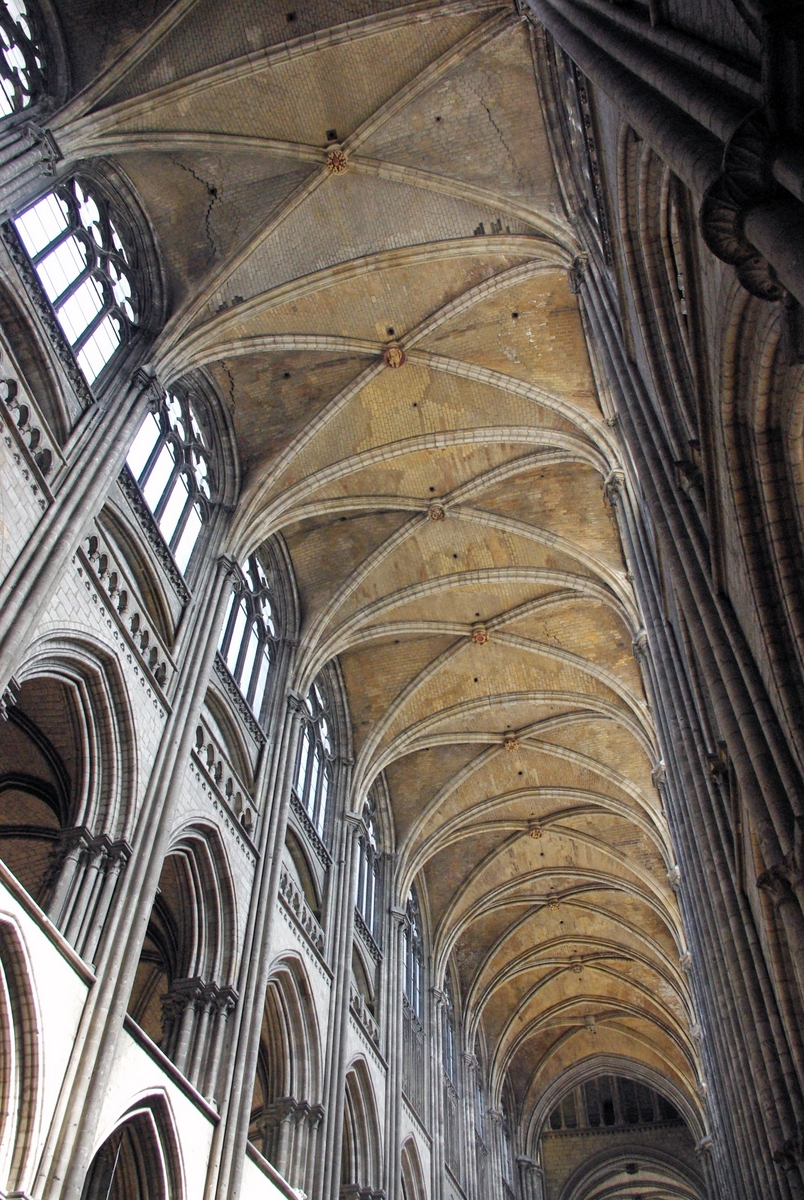
Like in Laon Cathedral, architects built the nave with a four-storey elevation (a characteristic of early Gothic), in contrast to the late Gothic style which adopted three. When the early Gothic focused attention downward (like in Rouen), late Gothic altered this tradition by drawing attention upward, to the heavens.

Eleven clustered columns and ten pointed arches on each side support the walls of the nave.
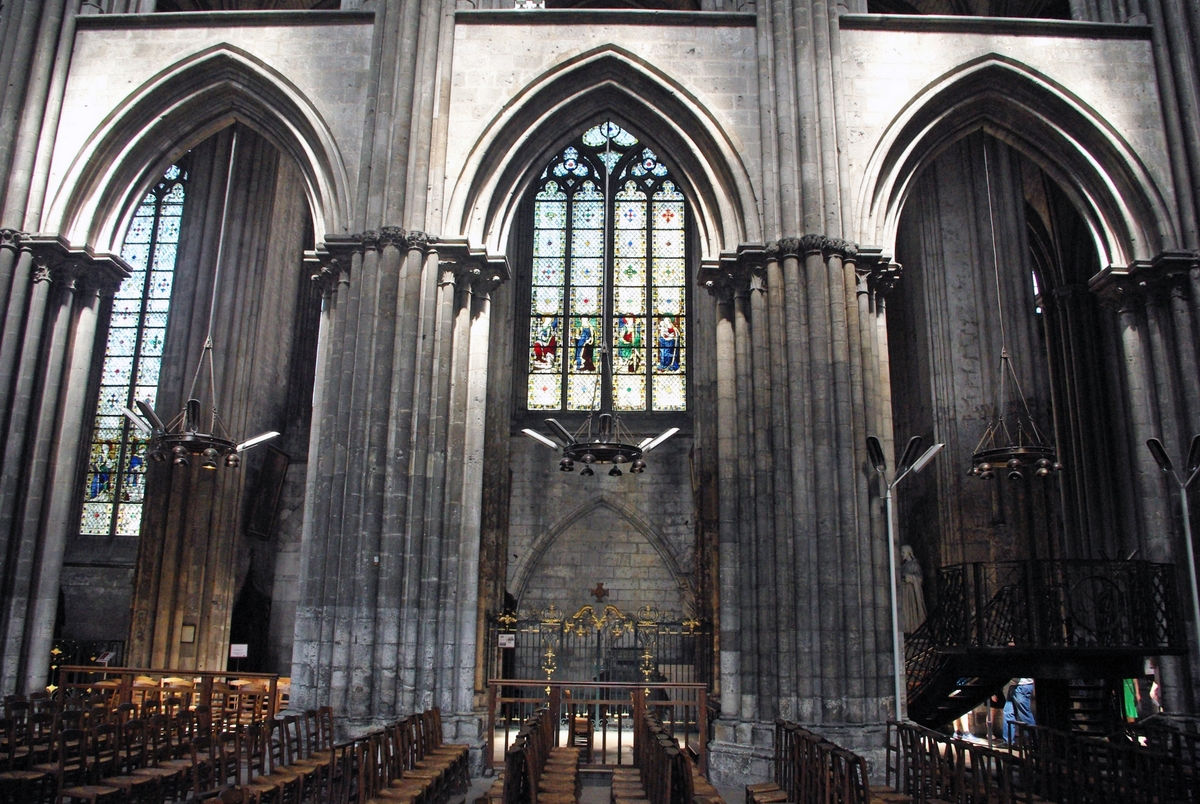
The side aisles of the nave

Eight chapels border the North side aisle (St. Mellon, St. John, St. Sever, St. Julian, St. Éloi, Chapelle des Fonts, St. Nicholas, and St. Anne), and seven border the South side aisle (St. Stephen, St. Leonard, St. Peter, St. Colombe, St. Catherine, St. Margaret, and Chapelle du petit Saint Romain).
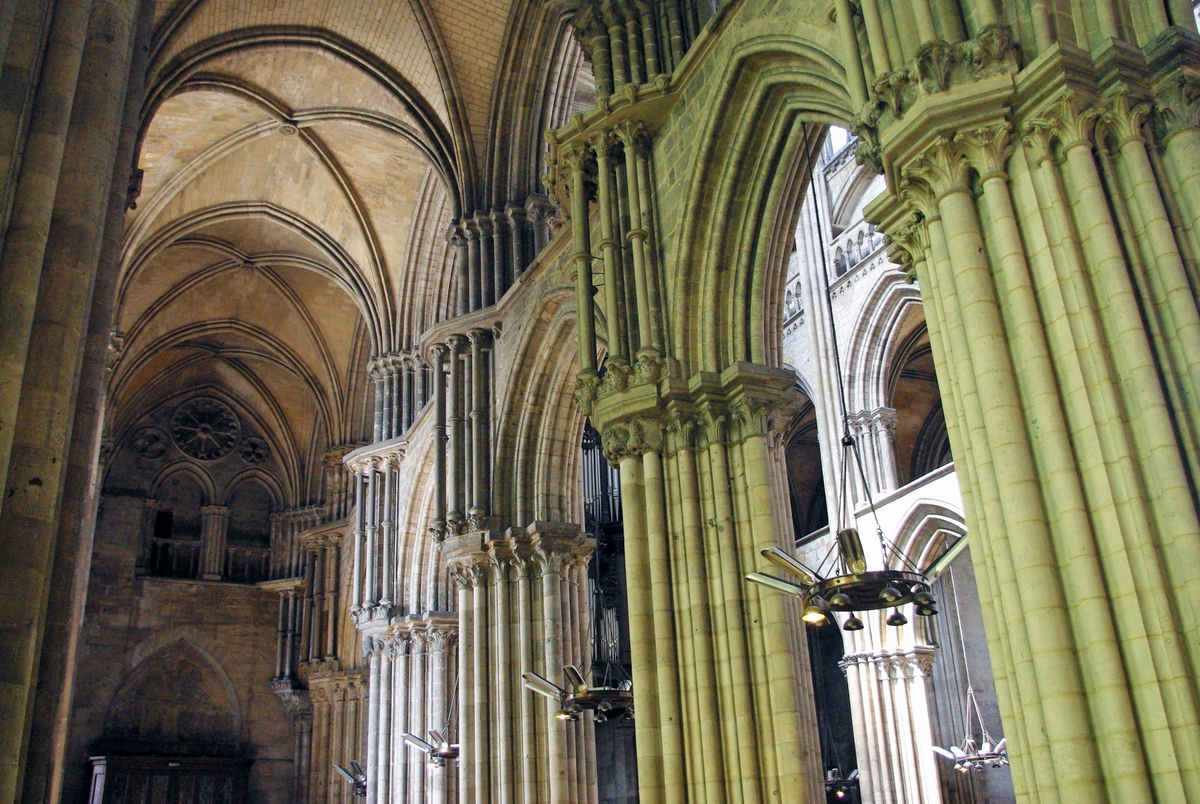
One of them, the Saint-Sever chapel on the northern side aisle, features the oldest stained-glass windows of the church, dating back to the 13th century. Called the ‘Belles Verrières’ as soon as the 14th century, they are the works of Guillaume Barbe circa 1465.
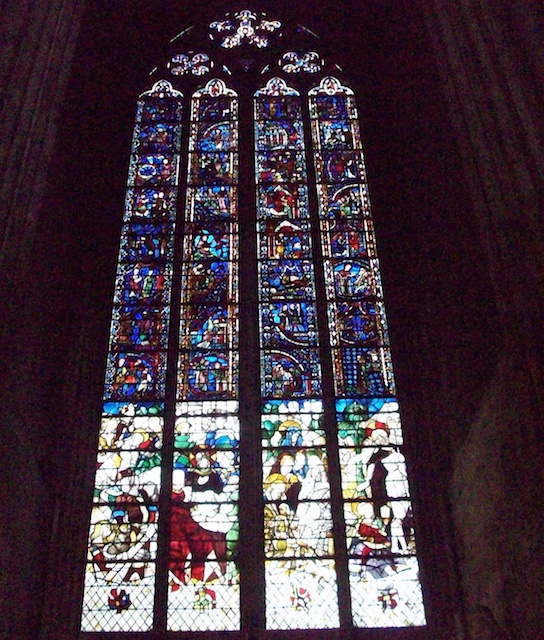
The Great Organ
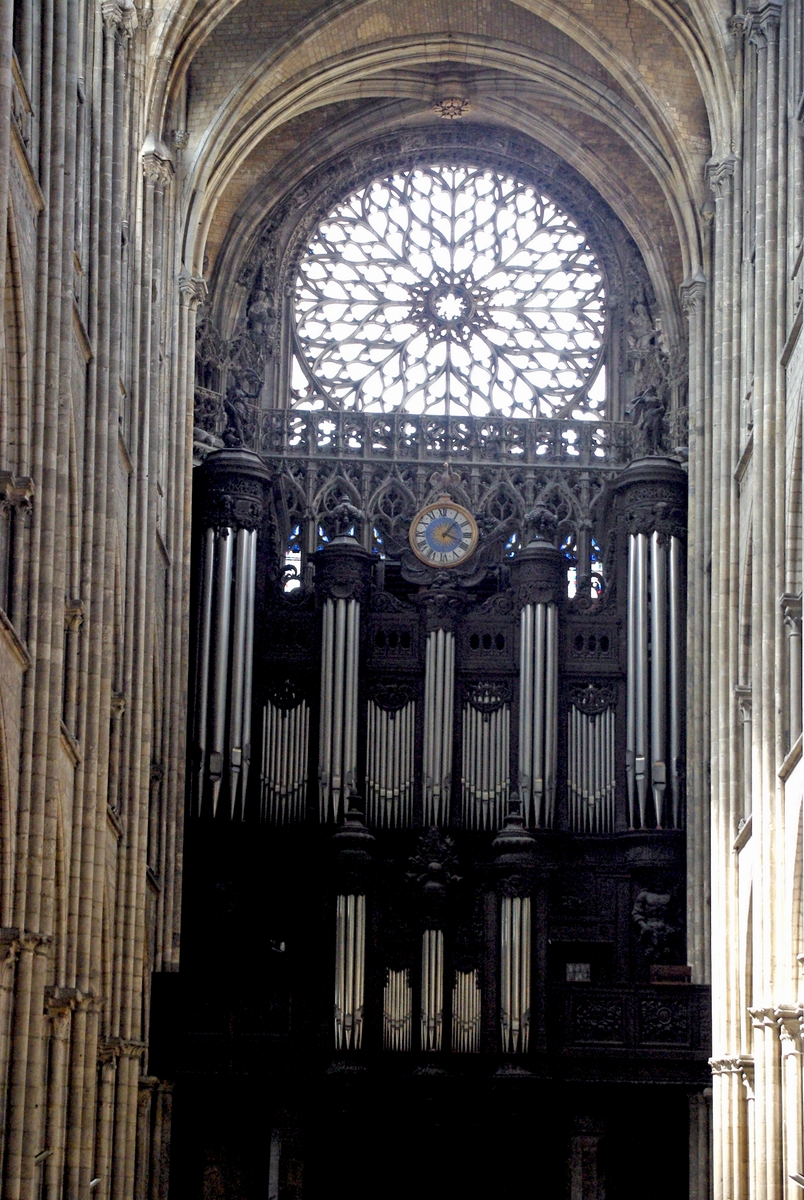
The Jacquot Lavergne factory built the great organ in the 1950s. Its inauguration took place in 1956. You will find it above the main entrance of the West front and under the great rose window.
The Transept
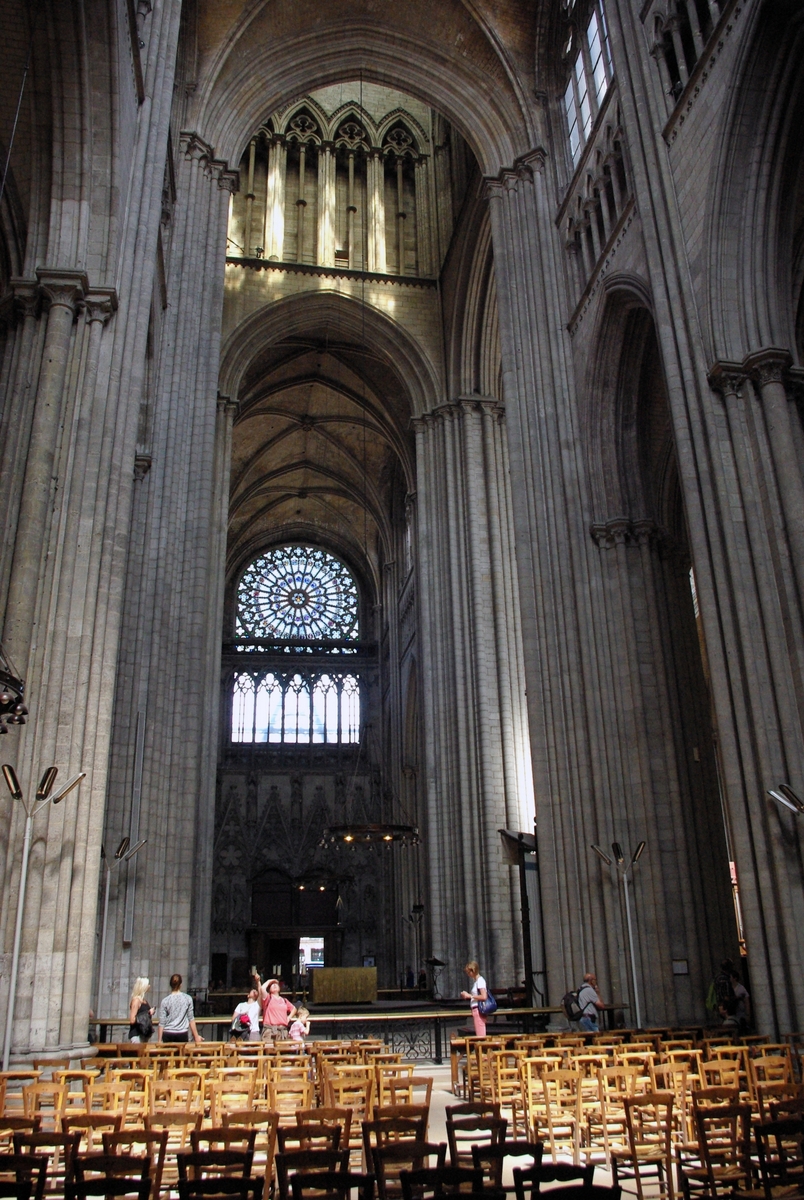
The two arms of the transept meet at the crossing where France’s tallest spire rises.
The North Transept
At the northern side of the transept, the “Librarian Portal” (Portail des Libraires) once provided private access for the canon priests. They could then safely return to their quarters. The rose window by Guillaume Nouel dates to the end of the 14th century. It is the only one of the three found in the cathedral to have kept its colourful stained-glass.
The North transept features a unique monumental Gothic staircase, the “Librarians’ Stairs” (Escalier des Libraires). It once led to the library and the chapter’s archives.

Guillaume Pontifs built the first two flights in 1479. The two last, also in Gothic architecture, date to 1788 to give access to the new archives floor. The delicate and beautiful staircase has boldness and lightness, peculiarly characterized by the French-Gothic style.
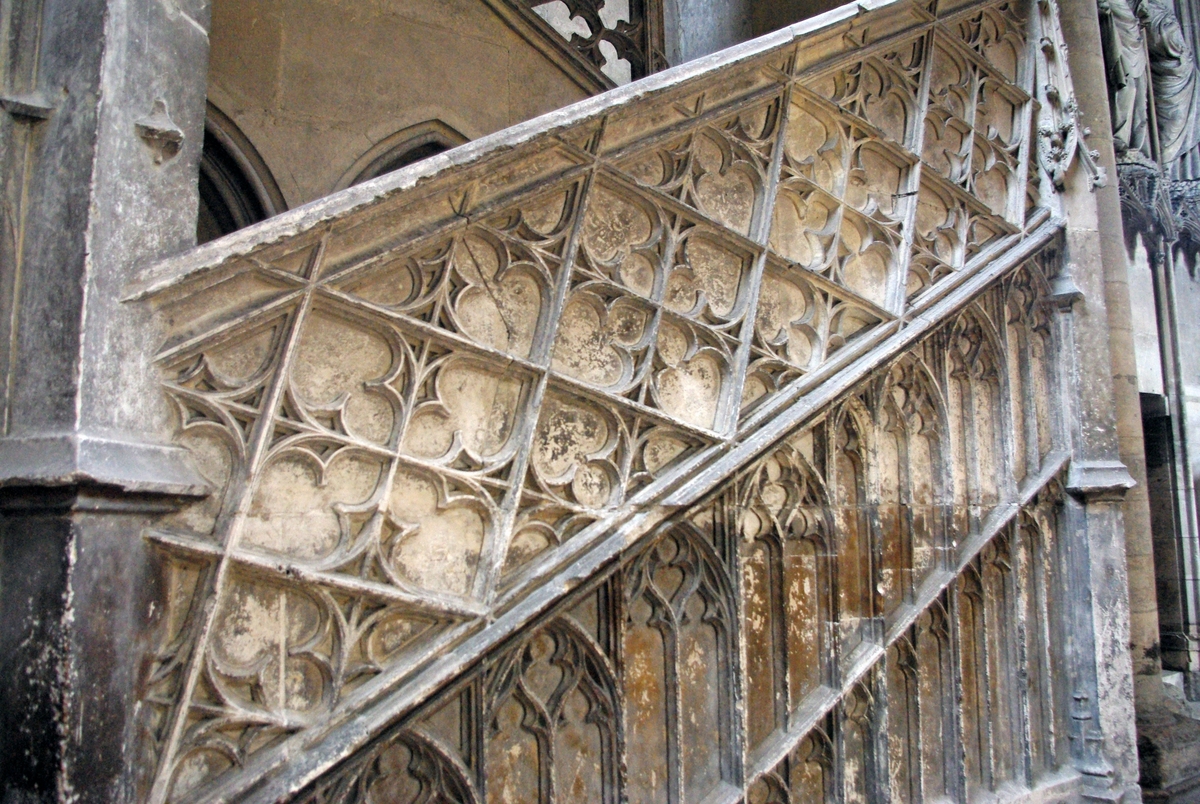
The South Transept
The southern side of the transept opens onto the “Calende Portal” (Portail de la Calende). To the right side, two stained-glass windows from the Renaissance decorate the portal.
The Lantern Tower
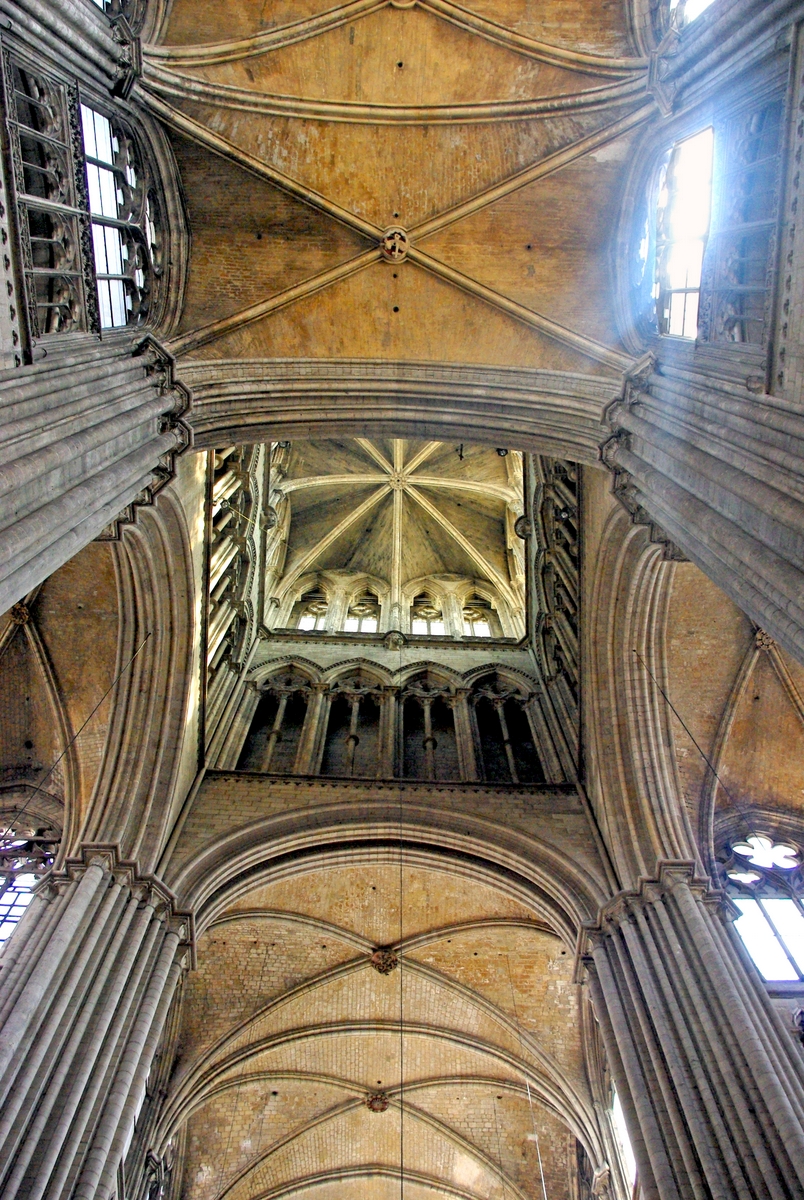
Four clustered pillars support the lantern tower above the crossing of the transept. The presence of a lantern tower at the crossing of the transept is a frequent feature in churches in Normandy (St. Ouen in Rouen, Bayeux) and in England (Canterbury, Gloucester, Salisbury, Winchester).
Find out more about the Lantern Tower.
The Choir
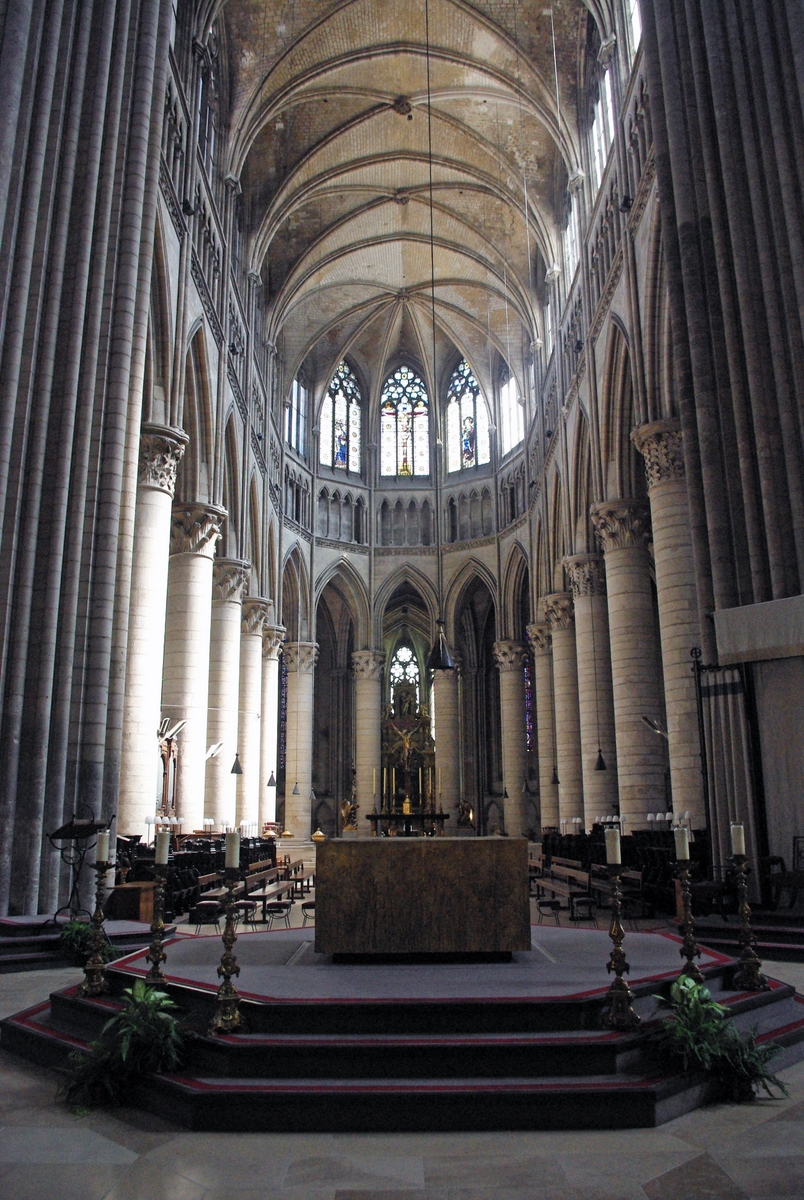
The choir of Rouen Cathedral is ascended from the transept by five steps. It comprises 14 soaring pillars and extends on five spans. Its pointed arcades and elegance make it the most sacred part of the cathedral.
The main altar is a table built in Aoste marble supported by the symbols of the four evangelists who wrote the four books of the Gospel: Matthew, Luke, Mark and John.
In the choir is also located the bishop’s throne – called ‘cathedra’, as the church is the See of Rouen’s archbishop.
Philippot Viard and Flemish cabinet makers sculpted the wooden stalls from 1457 to 1470. Only 66 of the 96 stalls originally installed in the choir remain today.
The choir has an organ from the Renaissance, and the furnishing was replaced following the bombings of 1944.
The choir is enclosed all around by an iron screen, which replaced a copper gilt one destroyed in 1793.
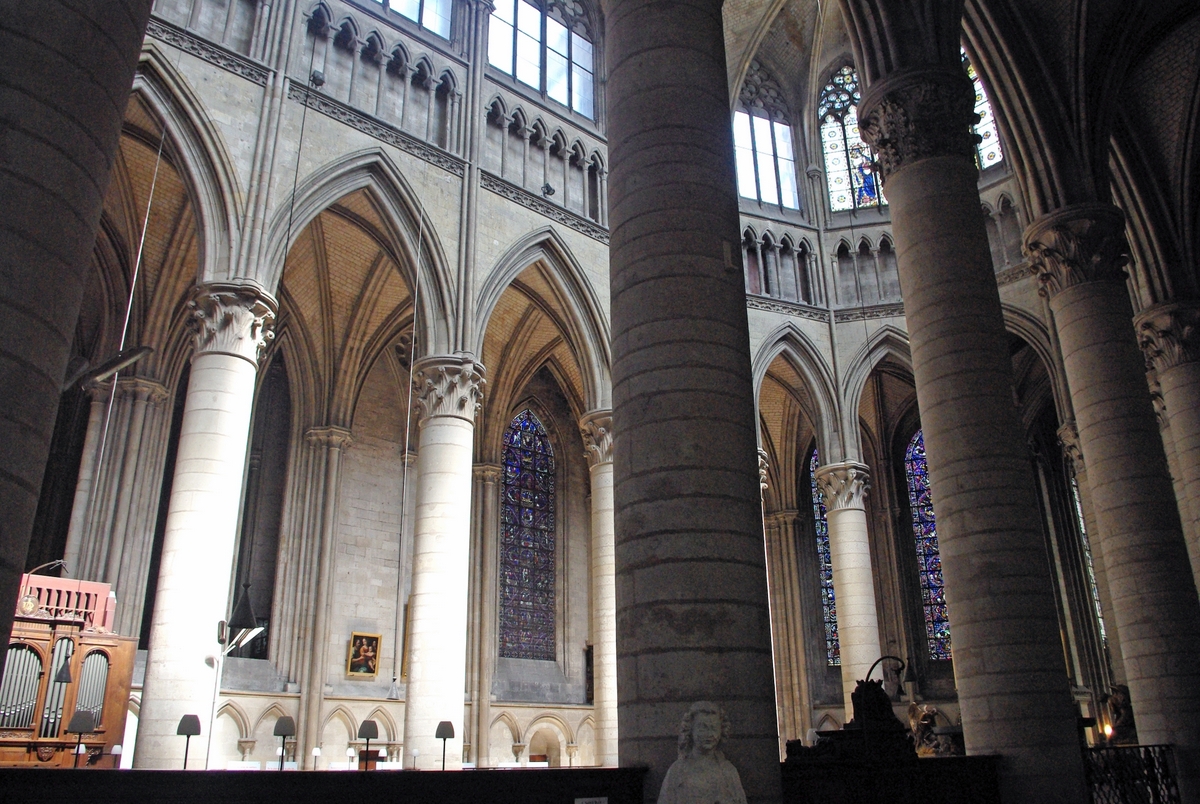
The ambulatory

The ambulatory surrounds the choir and is lightened by beautiful stained-glass windows from 1220-1230. The South side of the ambulatory is lined by statues that initially stood on the West front façade. In fact, copies replaced them onto the façade as restorers considered them too fragile or too damaged to be put back there again.
The recumbent statues of the ambulatory
The ambulatory contains the tombs of a few Dukes of Normandy. Many of them are recumbent statues, that is, life-size statues dressed in their daily costumes lying supine. In other words, recumbent literally means “lying in repose.”
Rollo (Rollon)

The recumbent statue of Rollo (or Robert) is a copy, as the original was destroyed during the war. Rollo is Richard Lionheart’s ancestor, the founder and first ruler of the Viking principality known as Normandy.
Richard the Lionheart (Richard Cœur de Lion)
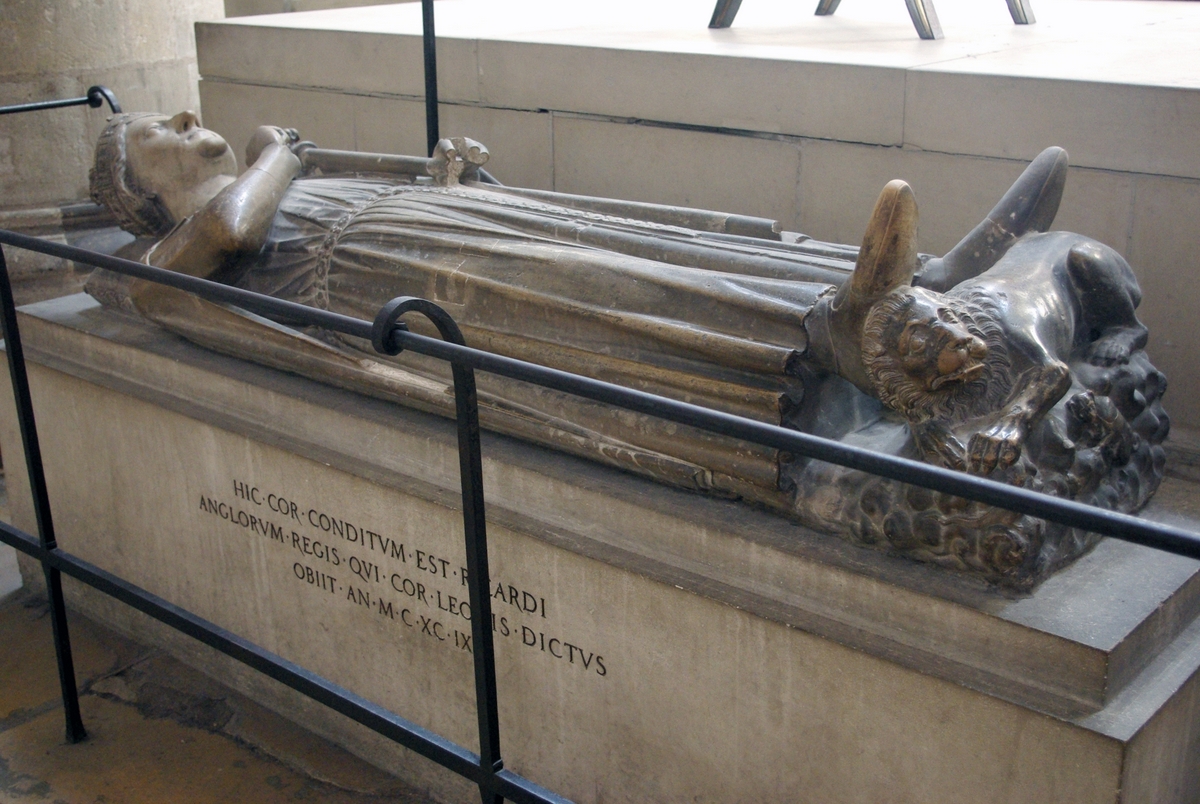
The recumbent statue of Richard the Lionheart only contains his heart. His bowels are buried within the church of the castle of Châlus-Chabrol in the Limousin, and the corporeal remains at Fontevraud Abbey near Chinon and Saumur in the Loire Valley. Richard is featured as a young man with his eyes opened. His feet rest on a lion, which was the symbol of the Resurrection in the Middle Ages. Finally, a Latin inscription on the tomb reads:
“This place holds the heart of Richard, King of England, who was named Lionheart and died in the year 1199.”
Henry the Young (Henri le Jeune)
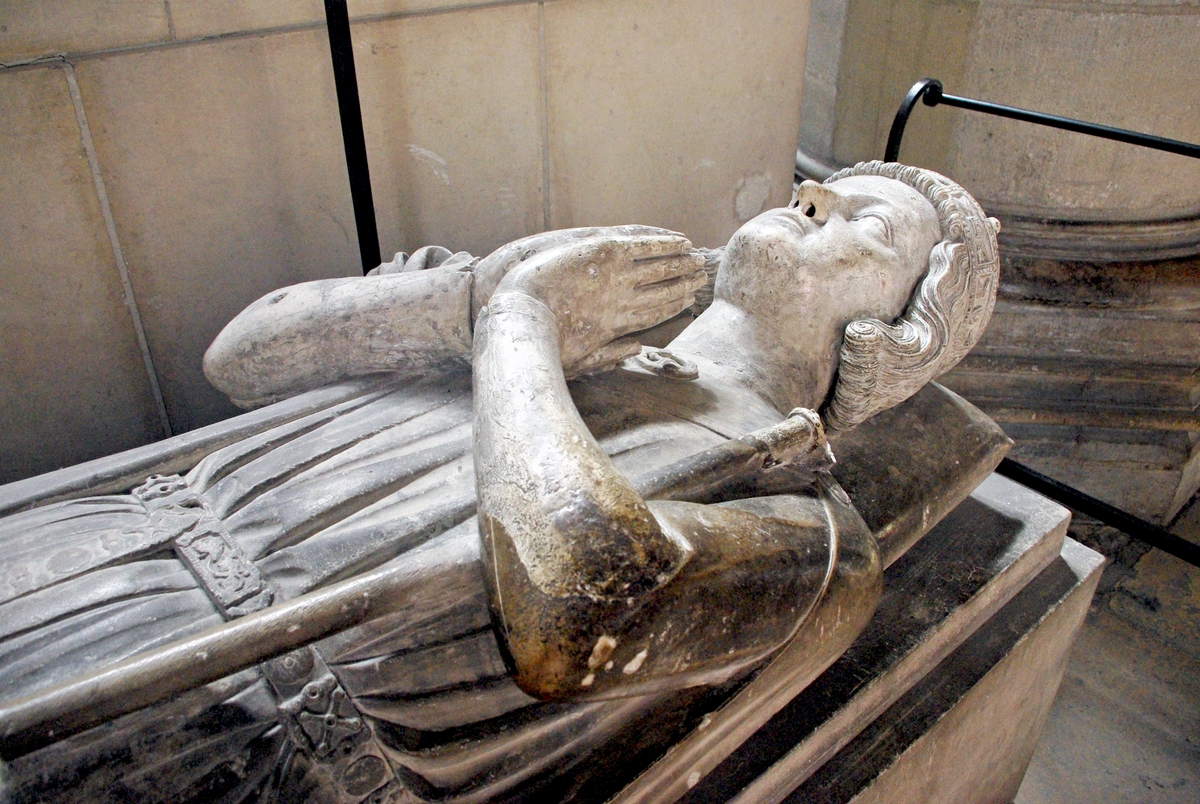
The tomb of Henry the Young looks similar to that of his brother Richard. It also dates from the 13th century.
William I Longsword (Guillaume 1er / Guillaume Longue-Épée)
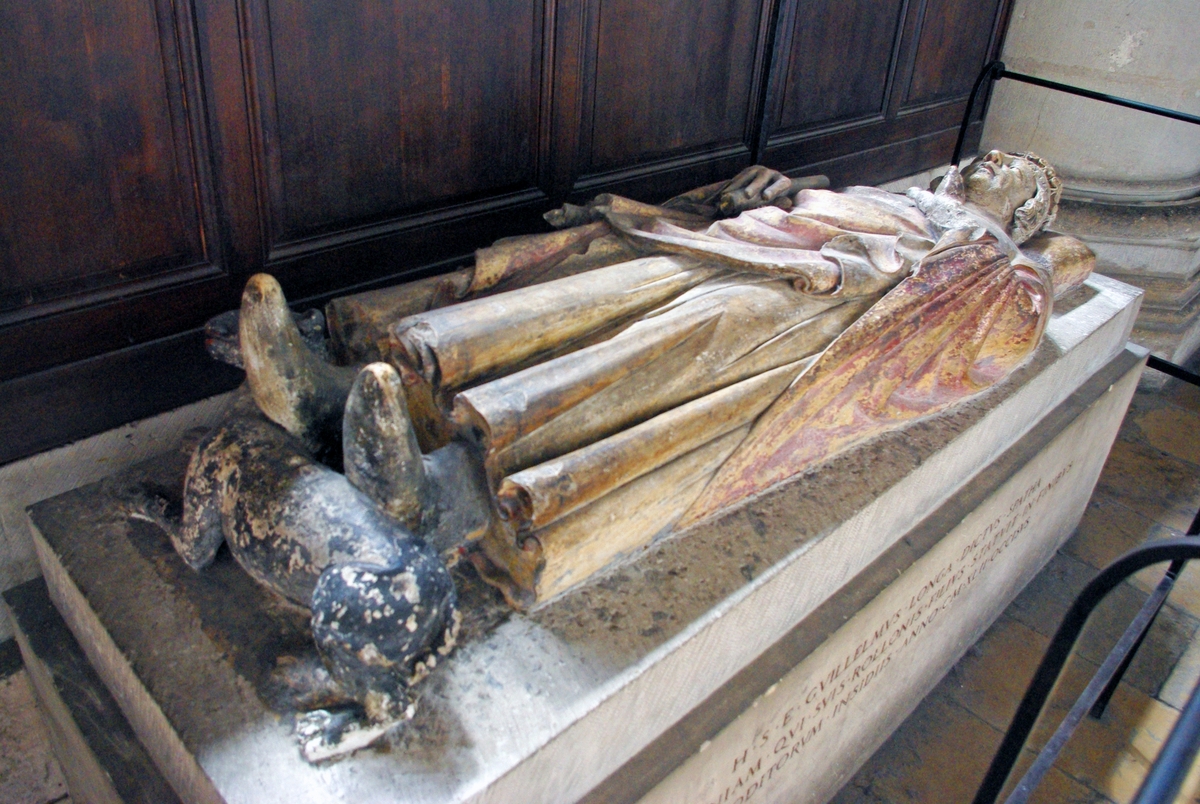
The recumbent statue of William Longsword, son of Rollo, dates from the 14th century.
Hugh of Amiens (Hugues of Amiens)

The tomb of Hugh of Amiens, archbishop of Rouen, was built into the wall. Under an arcade bordered by angels, the recumbent statue shows the mitre, the ring and the crozier, symbolising the bishop’s authority. In fact the Romanesque-style tomb is France’s oldest recumbent statue in France and dates back to the 12th century (which is older than the Gothic cathedral of Rouen).
John Lancaster (Jean de Lancastre)
In the ambulatory is a commemorative plaque of John Plantagenet, also known as John Lancaster, the Duke of Bedford. Locals regarded him as Joan of Arc’s murderer. He owed his right to a tomb inside the church to his duty as a canon priest of the cathedral after Joan’s death.
However, the Calvinists destroyed the original tomb during the wars of religion.
Stained-glass windows
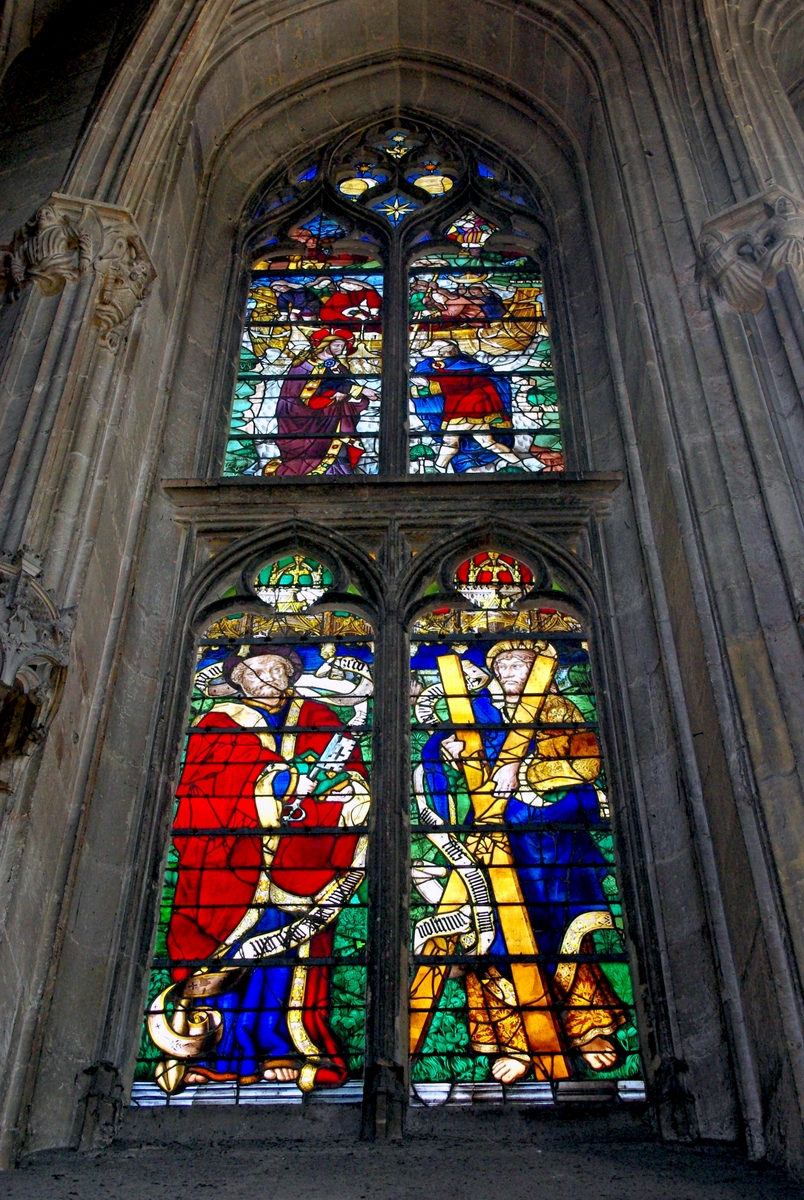
On the northern side of the ambulatory, some 13th-century stained-glass windows can be admired, such as those telling the legend of St. Julian the Hospitaller, which inspired French writer Flaubert in his book ‘Three Tales (Trois Contes). They are famous for their peculiar cobalt blue, known as ‘the blue from Chartres‘.

All the old stained-glass windows were taken down in 1939, at the start of the war, as a precaution to prevent their destruction, and sent to the basements of the castle of Niort.
The Lady Chapel

The Lady Chapel is situated in the apse. When the original chapel became too small, it was decided to rebuild it in 1302 in Rayonnant Gothic.
The new sanctuary was longer, higher and brighter. It is lighted by nine windows executed in 1485 full of rich painted glass, representing mainly portraits of the archbishops of Rouen in their robes.
The chapel contains the Renaissance tombs of the cardinals of Amboise, of the Prince de Croy (Archbishop of Rouen from 1824 to 1844) and of Louis de Brézé, Seneschal of Normandy, who died in 1531). Behind the altar stands a large altarpiece sculpted in the 17th century and dedicated to the Virgin.
Rouen Cathedral in painting
The impressive sanctuary of Rouen Cathedral has been the subject of numerous paintings, notably by the Impressionist Claude Monet.
Rouen Cathedral by Claude Monet (1892-1893)
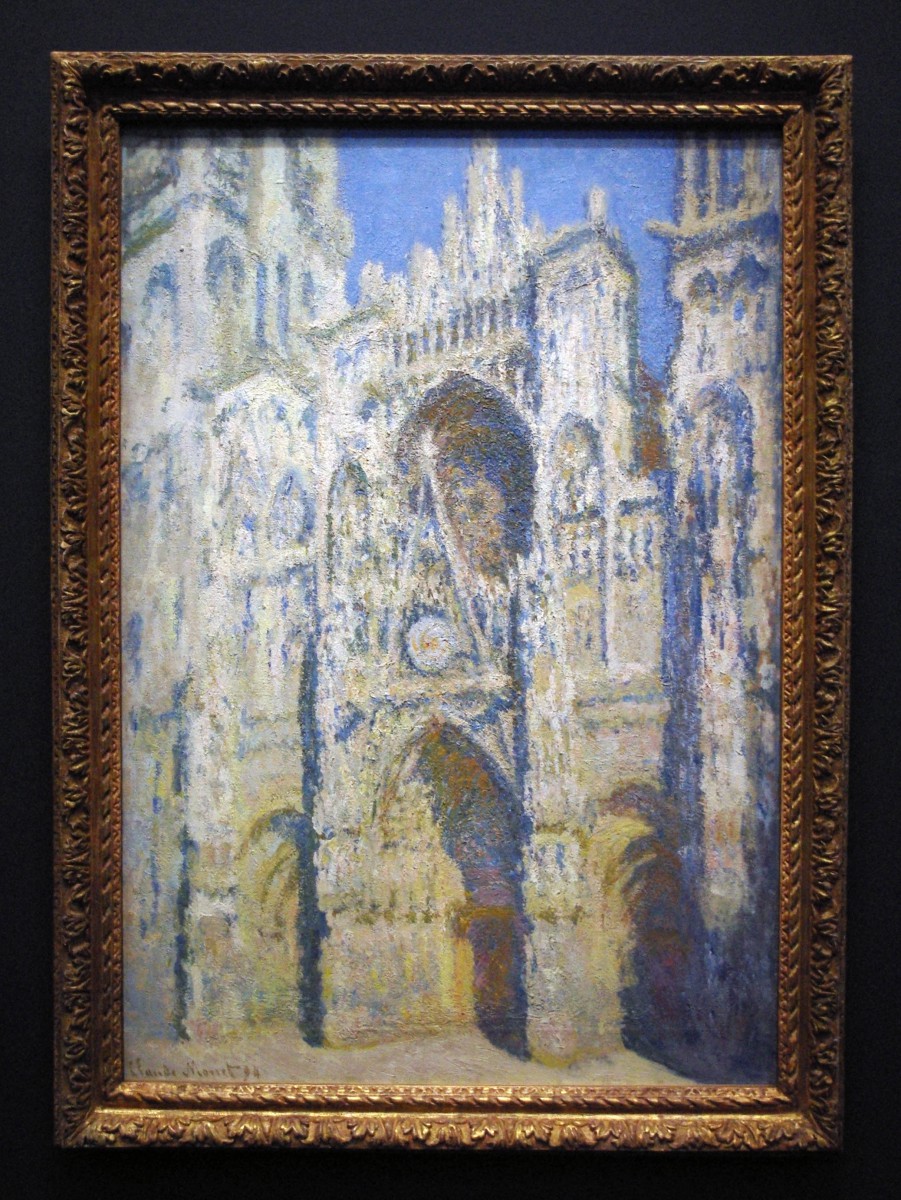
The West front, with its fantastic set of towers, pinnacles, gables, statues and porches, was often painted by Claude Monet. The impressionist painter composed a series of 30 paintings of the Western facade at different times of the day. His work is exhibited in various museums spread between America (National Gallery of Art, Washington, D.C., Getty Center, Los Angeles) and Europe (National Museum of Serbia, Belgrade, museum of Cologne, Germany, Fine Art Museum, Rouen Fine Arts Museum and Paris’ Musée d’Orsay).
Rouen by Richard Parkes Bonington (1825)
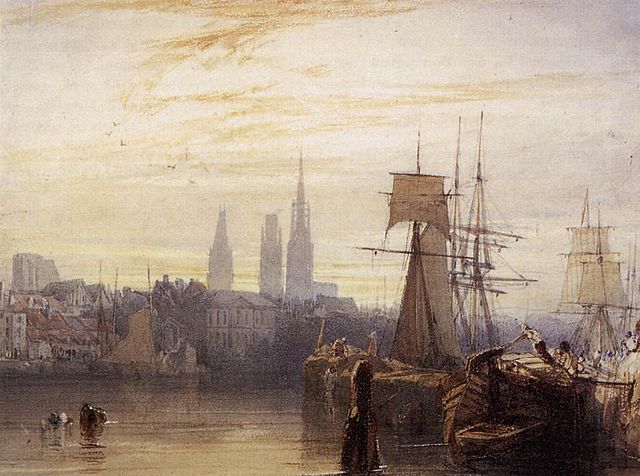
The Cathedral of Rouen by Joseph Mallord William Turner (1832)

Chevet of Rouen Cathedral by William Parrot (1860)
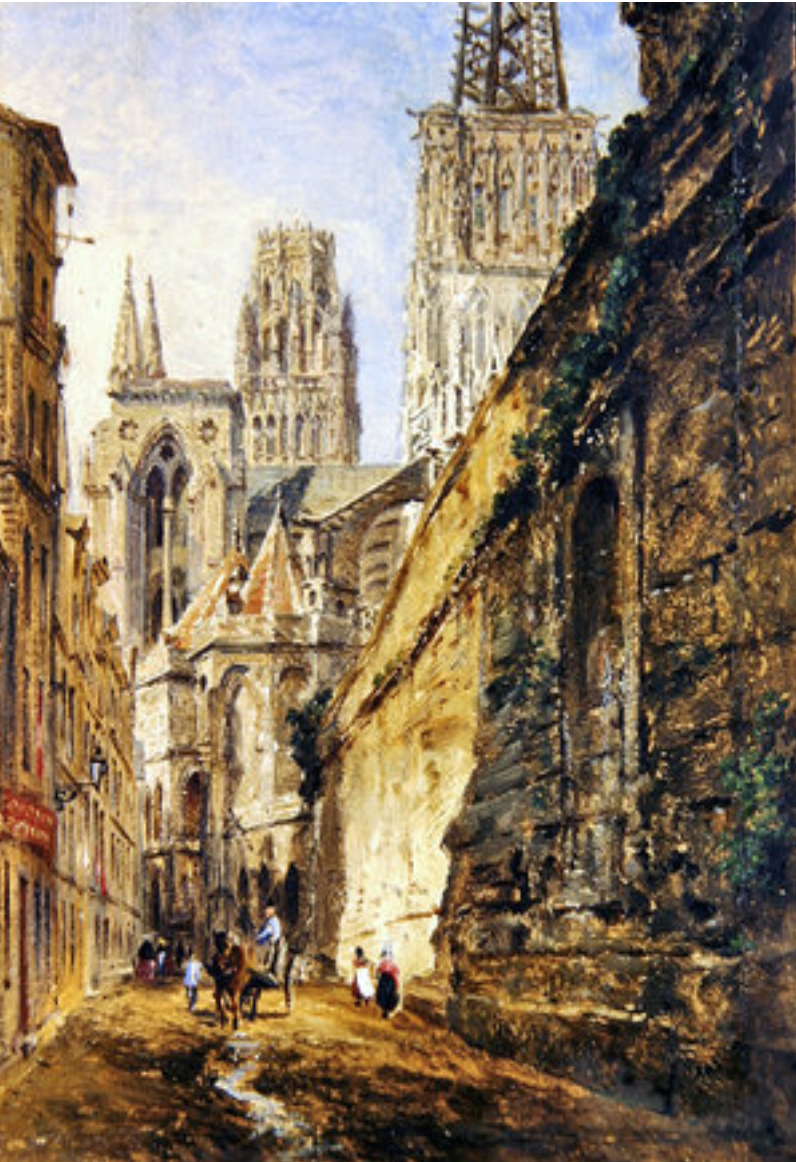
The Cathedral seen from rue de l’épicerie by Camille Pissaro (1898)
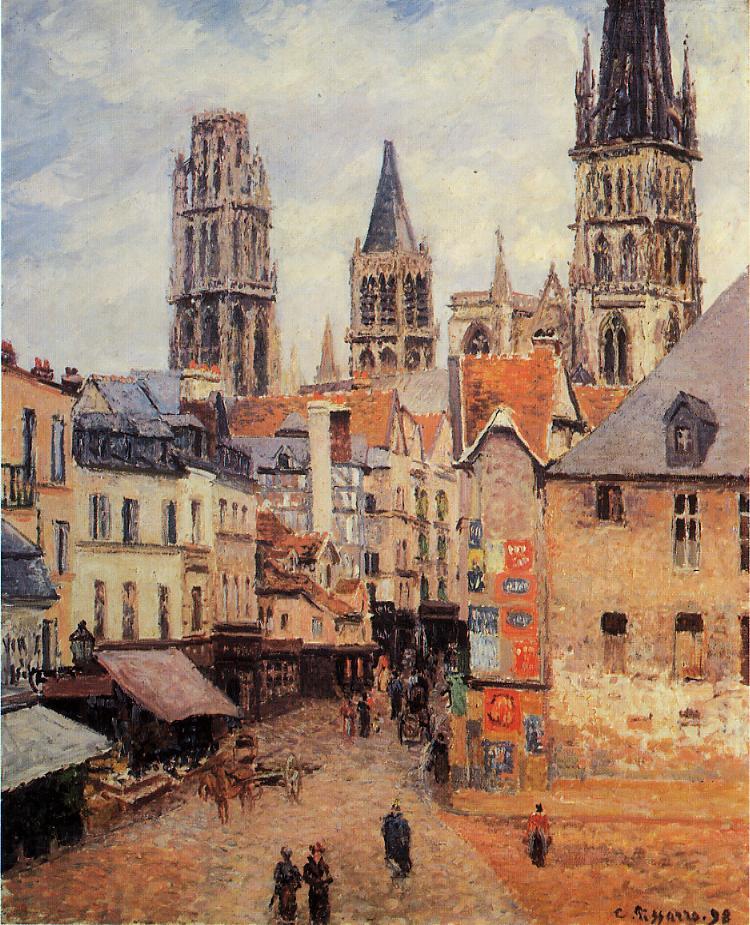
Quai de Paris and the Cathedral by Johannes Bosboom (1839)
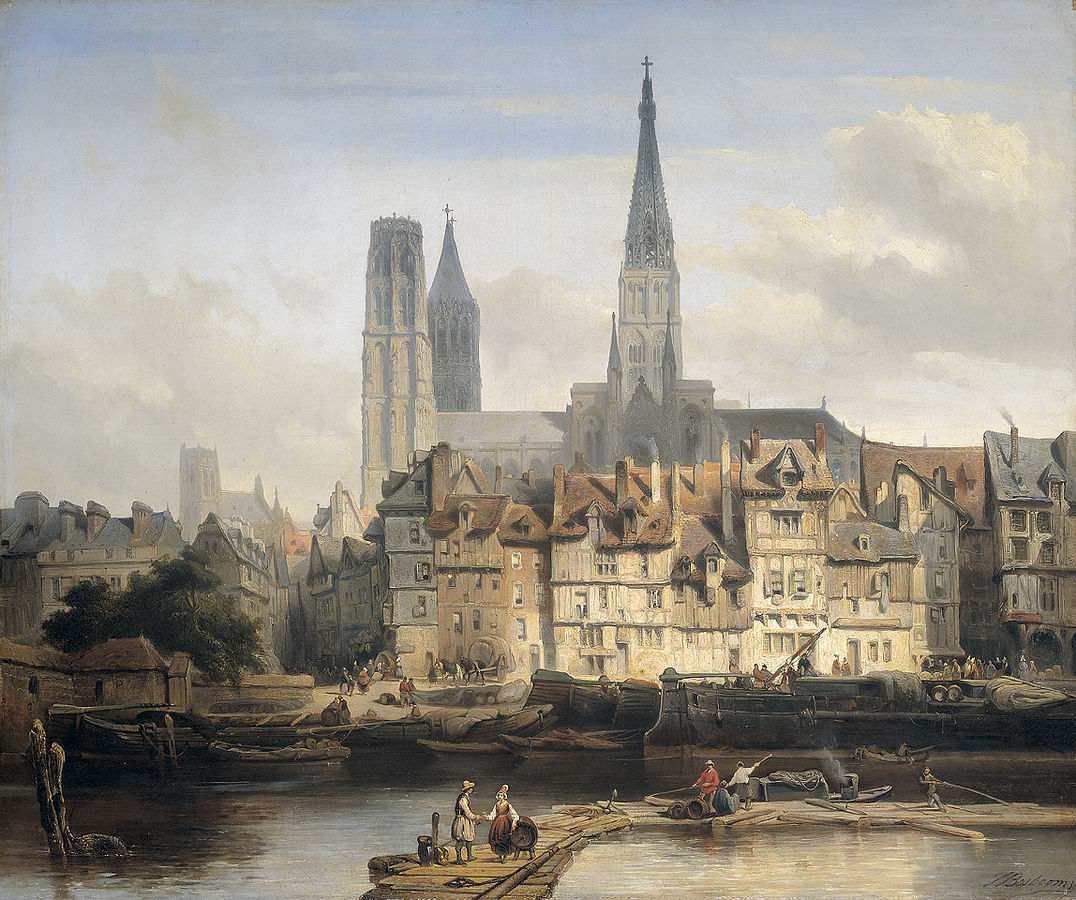
The City of Rouen from the Left Bank by Charles Fréchon (1900)
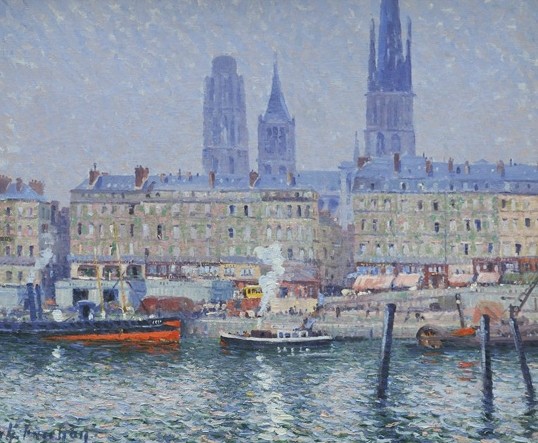
Rouen from afar by Camille Corot (19th C)
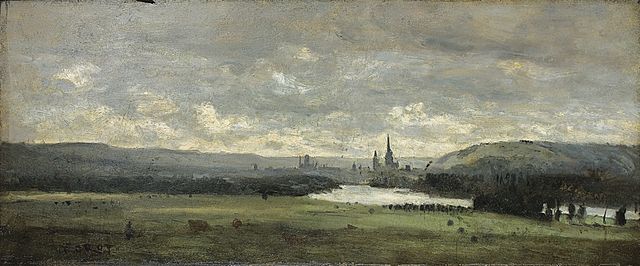
Rouen Cathedral: more info
Here are a few websites and blogs about Rouen Cathedral that you might find helpful:
- on the blog: Rouen Old Town
- the official website of the cathedral of Rouen
- to book your accommodation in Rouen, click on this affiliate link, which will redirect you to our partner
- Tourist Board of Rouen
- Tourist Board of Normandy
- Wikipedia’s article on Rouen Cathedral
The cathedral is open Monday from 2-7 pm (6 pm in Winter), Tuesday to Saturday from 9 am-7 pm (6 pm in Winter), and Sunday from 8 am-6 pm.
Things to do in Rouen, Normandy
Looking for activities and things to do in Rouen? Check out the offers from our partner Get Your Guide:
Pin it for later!


